“Women today have different needs than we have had in the past, but beauty companies haven’t necessarily been the most reactive to that,” says Emily Weiss who launched Glossier, the skincare and cosmetics brand in 2014. “We wanted to create a very democratic movement, and the channels most fitting that goal were direct, digital ones.”
What started as a beauty blog, grew into a $1.2B company, thanks to a passionate fanbase who spread the word and co-created best-selling products.
Co-creating products with superfans
Glossier is most famous in the industry for how effectively they leveraged Into The Gloss beauty blog readers for crowd-sourcing and product co-creation. A typical product-sourcing post gets 300+ detailed comments. This feedback then informs product, packaging, copy and ad campaign decisions.
Quick example: when sourcing their best-selling moisturizer, Glossier wanted to go with jars for the packaging. Feedback from customers suggested jars were viewed as less hygienic, and the brand went with a pump. Other feedbacks they integrated was related to preferred products, texture and ingredients.

While a popular blog is a useful engagement tool, other brands are constantly engaging with their fans on social media platforms to listen and learn, to inform and inspire, to drive sales or explore new ideas. Social polling, competitions, product features, flash sales, consumer views, events, are all aspects of this.
Turning consumers into influencers
Infleuncers isn’t a new concept in retail, especially in the beauty industry. But Glossier’s version is – unsurprisingly – more community-driven than most.
The brand selects loyal fans that fit their brand and have an existing – albeit small -social media following (most of them have between 300 and 5,000 followers). “Reps” share their skincare routine and favourite products on their profile page. Their custom link gives new shoppers 10% off their first order.

This way, Glossier controls its image while leveraging their passionate customers for added business.
Generating social proof at scale
The Glossier social team excels at engaging their audience and sourcing customer generated content (UGC) daily. Fans are encouraged to share their daily Glossier look.
You only need to look up #GlossierIRL on Twitter to see it:
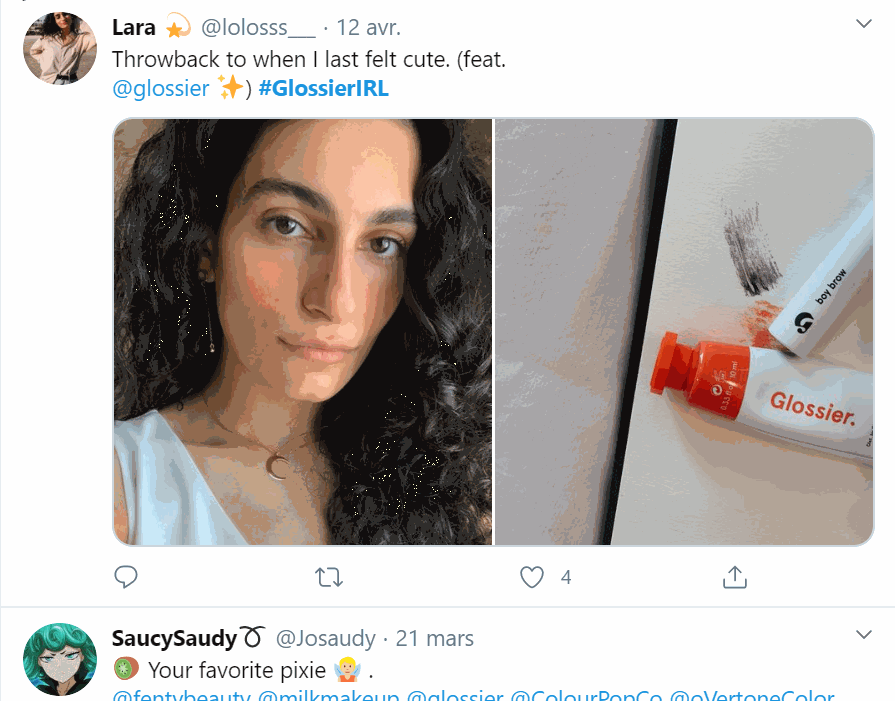
And #GlossierGirl on Instagram:

Here’s the 2 key drivers behind Glossier’s ability to drive user-generated content:
- The brand’s pop-culture-savy, fun and approachable tone on all channels is aligned with their younger audience and gets their attention
- Glossier rewards that attention by replying to every mention and sharing customer content on all brand channels (social media, product pages, ad campaigns, newsletters)
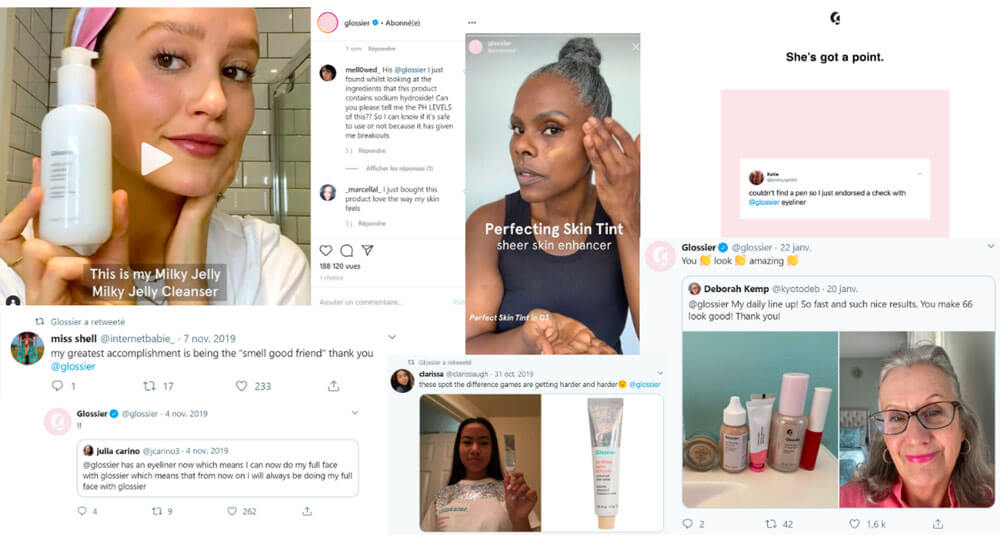
Consumer tutorials and beauty routines
Tutorials are essential for any beauty brand. Not only does it showcase the product, it helps customers figure out how to make it work for them.
The Glossier blog started by posting beauty routines and #shelfies (where people post a picture of their top shelf with their favorite beauty and skincare products). It’s what made the blog so successful in the early days.
No surprise then that the brand still heavily relies on sharing customers’ beauty routines and tutorials on social media:

Community-powered marketing programs
Glossier actually goes beyond featuring their customers on their social channels: they include them in national ad campaigns. This echoes the company’s number 1 rule for community: “Make the Consumer Feel Seen”.
It also adds a layer of authenticity and additional social proof to the brand’s ads. There’s also the smart use of reviews on product pages, their 18k member non-branded beauty community on Facebook
(See their other 3 rules for building an engaged community here, by their CFO Henry Davies)
Glossier’s community has been a crucial driver for acquisition and customer loyalty.
“Humanity’s 21st century challenge is to meet the needs of all within the means of the planet” says economist Kate Raworth. “In other words, to ensure that no one falls short on life’s essentials (from food and housing to healthcare and political voice), while ensuring that collectively we do not overshoot our pressure on Earth’s life-supporting systems, on which we fundamentally depend – such as a stable climate, fertile soils, and a protective ozone layer.”
She illustrates the challenge as a doughnut, with social and planetary boundaries.
The doughtnut’s outer boundary reflects our environmental limits (air pollution, biodiversity loss, land conversion etc), beyond which lies ecological degradation and potential tipping points in Earth systems. The doughnut’s inner boundary reflects our social limits (health, education, justice, equality etc), reflecting that the agreed minimum social standards in UN’s the Sustainable Development Goals.
Between social and planetary boundaries lies an “environmentally safe and socially just space” in which humanity can thrive.
In 2018 Raworth applied the model to to 150 countries in a study for the G20. Her findings were provocative, saying “The doughnut challenge turns all countries – including every member of the G20 – into ‘developing countries’ because no country in the world can say that it is even close to meeting the needs of all of its people within the means of the planet. In fact Vietnam is the closest country to it. Some countries like India act within environmental limits but fall short socially. Industrialising nations like China are now crossing environmental limits, whilst high-income nations like USA massively overshoot both boundaries.
Most recently, Amsterdam became the first city to embrace the model as a framework for its future development.
The doughnut was originally developed by economist Kate Raworth:
- Nature Climate Change interview on the implications of the doughnut
- Centre for Humans and Nature article on what Doughnut Economics implies for economic growth
- State of the World 2013 chapter on planetary and social boundaries as a 21st century compass
- Guardian blog presenting the doughnut in the context of the UN’s Rio+20 conference
- Guardian podcast on planetary and social boundaries

The Lake Biwa Marathon is the oldest in Japan – last year’s edition saw 42 local runners break 2 hours 10 minutes for the distance, the most ever in one race, anywhere – the US Olympic trial saw one runner under that time, while in the UK there were none. Yet hardly any of these Japanese runners win gold medals, or are known outside their home nation.
Japanese culture focuses on teams rather than individuals, on contribution towards collective goals rather than personal fame and fortune.
This is illustrated by the Hakone Ekiden, a long-distance running relay, and Japan’s most popular televised sporting event. Traditionally run over three days between the ancient capital Kyoto and Tokyo, a distance of 508km, it now consists of a corporate race every New Year’s Day, and a student race on the two following days. The collegiate race is the bigger event, with 52.6 million tuning into watch this year, 40% of the population.
Every top Japanese athlete aspires to join a corporate team – becoming employees with extra time off for training. Japanese brands are seen as national icons, and representing one is seen as the highest accolade for the individual, rather than an athlete’s endorsement for the company. This year’s corporate Ekiden winner was the Honda team, followed by Subaru, Asahi, Mitsubishi and Toyota.
The challenge for Japanese leaders
Japan is the world’s third largest economy, but has largely stagnated in recent years, and is ranked as the world’s fourth least entrepreneurial country in the world.

Japan thrived in the post-war years with disciplined approaches such as “Kaizen”, built around continuous improvement methods such as just-in-time, zero defects, “Kanban”, suggestion systems, automation, small group activities, total productive maintenance, total quality control, and more.
The incremental improvement approaches drove world-leading standards in quality, efficiency and productivity, and the rise of a generation of product- and cost-leaders like Sony and Toyota. But it was essentially a discipline for stable, product-centric markets.
As in the Hakone Ekiden, being a team player is seen as essential in Japanese culture. Rather than being a figurehead and decision-maker, leaders exist to consult with teams, to find consensus. This drives hierarchical working, feeling the need to be involved in everything their teams do.
It also limits ambition and challenge, innovation and growth.
Japan has the world’s most participative style of leadership, but also the least visionary style of leadership, according to a report on Japanese leadership by executive search firm KornFerry.
In a world of relentless change both matter – future direction and collaborative action.
“Vision” is typically regarded as too abstract, vague, and general in Japanese business culture. Managers and employees want the detail, the absolutes, the certainty. But in a world of change, details keep changing – agility becomes key, the ability to keep adapting and improvising matters more.
Similarly, change is not easy in Japanese business culture. Western change management models typically focus on the role of leaders, and others, as “change agents”. This doesn’t work in Japanese culture according to a report on change management in Japanese culture by McKinsey.
Individuals who seek to challenge the status quo, catalyse new ideas, and inspire change, are seen as disruptive, threatening the carefully developed harmony of teams and organisations.
Change narratives that lack detailed implementation aren’t believed, and “cascading” new approaches doesn’t work. Change, according to McKinsey, needs to be more hands on, to address the blockers of change, to make specific process or behaviour improvement, and direct to every part of the organisation.
These differences in culture are not new to us, and are brilliantly illustrated by Erin Meyer in “The Culture Map” showing the extreme hierarchical and consensual nature of Japanese culture.

Finding a new approach for Japanese leaders
In my new book “Business Recoded” I explore leaders across the world who are shaking up markets, and their organisations. Some of the most interesting leaders are Japanese.
As Japanese business shifts away from traditional manufacturing-based industries to more intellectual pursuits – from fashion design, to software and finance – leaders needs different skills.
Masayoshi Son, CEO of SoftBank is one Japanese leader who has vision in abundance. He is often called the most powerful man in technology, because of his huge investments in companies from Alibaba to Bytedance, Coupang to Didi, Nvidia and Uber.
Son has an obsession for technological developments, and a 300 year plan for driving corporate success. Some of his investments are truly visionary, like his early stake in Alibaba, while others have been less good, like WeWork. Yet his long-term portfolio approach can cope with failures on the longer journey to success.
Similarly, “don’t take it too seriously, you’ll eventually find success” is the advice of Tadashi Yanai, CEO of Fast Retailing which owns retail brands like Uniqlo, and the French brand, Comptoir des Cotonniers.
Yania says “Uniqlo is not a fashion company, it’s a technology company.” And indeed, the brand’s approach to making apparel has more in common with the iterative approach to product development embraced by the technology industry than the cyclical, trend-driven rhythm of the fashion industry.
Noriaki Horikiri is the leader of Kikkoman, one of the world’s oldest companies. The Japanese soy sauce brand can trace its roots back over 350 years to a family business, that made sauce for the Emperor’s palace in Osaka. It has remained one of the most recognised symbols of Japanese industry and culture.
Yet Horikiri knows that he needs to innovate his traditional business to keep pace with changing markets, consumer tastes and global competition. In recent years, he has developed a diverse portfolio of sauces and other food ingredients, all under his brand. His challenge, though, is to balance tradition with newness.
Combining heritage and creativity
I work with a great variety of Japanese organisations, with a focus on helping their leaders to make sense of a changing world, to see the opportunities unlocked by that change, to drive innovation and transformation across their business, and to find new ways in which they themselves can be more effective leaders:
- Asahi is building a global portfolio of drinks, and has the challenge of engaging with young people in a social, gamified world.
- Canon, from photography to printers, is trying to shift from its technological product obsession to focusing on customers, and solving their real problems.
- Fujitsu is applying its technological solutions to a changing world, in particular focused on smart cities, and improving human life.
- JTI, the tobacco business, is seeking to respond to rapid changes in consumer attitudes to health and well-being, to grow in new ways.
- Sompo, the insurance business, recognises that the best way to reduce risk is to improve how people live, creating a “theme park” of new services.
- Suntory, the leading drinks business with brands from Jim Beam to Orangina, seeks to embrace sustainability in more profitable ways.
- Takeda, the leading pharma business, sees the opportunities of health and wellbeing, rather just being obsessed with the bioscience of drugs.
What have I learnt from working with these companies?
Japanese companies have some great strengths to build on
- a profound sense of purpose, to contribute long-term to a better society – indeed many of the best purpose statements, and sustainability initiatives can be found in Japanese companies
- a deep belief in collaboration, in the ability to achieve more together – typically within an organisation, to engage people in a shared direction, to seek a harmonious approach
- a commitment to success – a dedication to hard work, endurance and resilience, and huge loyalty to companies, increasingly rare in western markets
but they need to combine these with new ways of working
- agility to drive strategy amidst change – to cope with complexity, ambiguity and uncertainty, and willingness – achieved through more spectrum, portfolio thinking.
- entrepreneurial spirit that drives more creativity, challenge, and innovation – not just as a process, but in the ideas of diverse teams, to embrace failure and learning, with safety in teams.
- an openness to work with other organisations, across geographies and sectors – as industries converge, and new skills are needed, to build ecosystems like we see in China and beyond.
So how are Japanese companies going about seeking to embrace change? Not least, as they becoming increasingly multinational, through acquisitions and partnerships, and reaching new cultures and audiences. And how can Japan break out of its economic blinkers, to drive new innovation and growth?
Asahi … reimagining the future
Asahi is a Japanese global beer, spirits, soft drinks and food business group headquartered in Sumida, just outside Tokyo, and now also owner of brands like Grosch, Peroni, and Pilsner Urquell.
The corporate philosophy of the drinks group is to “satisfy customers with the highest level of quality and integrity while contributing to the promotion of healthy living and the enrichment of society”.
Atsushi Katsuki, CEO of Asahi Breweries says “as a brand, our philosophy is you get the most out of life, not by following the path, but by exploring and re-inventing the future and there’s no country in the world that does this better than modern Japan.”
Canon … finding yourself
Based in Ōta, Tokyo, it specialises in optical, imaging, and industrial products, such as lenses, cameras, medical equipment, scanners, printers, and semiconductor manufacturing equipment. It’s 80-year history is built on a DNA which it describes: a respect for humanity, an emphasis on technology, and an enterprising spirit that the company has consistently passed on since its foundation.
“Kyosei” is the key philosophy, meaning “all people harmoniously working together”. The company says “it conveys our dedication to seeing all people, regardless of culture, customs, language or race, harmoniously living and working together in happiness into the future”
Canon then, rather bizarrely and almost in denial of a volatile world, adds “Unfortunately, current factors related to economies, resources and the environment make realising kyosei difficult” and says it strives to eliminate these factors.
“The Three Selfs” is another guiding principle, and could help to resolve this confusion:
- Self-motivation: Take the initiative and be proactive in all things
- Self-management: Conduct oneself with responsibility and accountability.
- Self-awareness: Understand one’s situation and role in all situations.
Fujifilm … driving innovation
The imaging business has come a long way since the days of camera film, when there was Kodak and Fujifilm. Today, Kodak is essentially gone, while the Japanese business has thrived. Through innovation.
Shigetaka Komori, CEO, says “Building from our legacy of innovation in photographic film, today’s Fujifilm is a technology company impacting the fields of healthcare, materials, business innovation and imaging. We will continue creating value from innovation, leveraging our advanced and unique technologies to solve social changes. We will never stop building our experience and expertise to transform ourselves and the world.”
The “never stop” mantra drives innovation in all forms – from products and services to new businesses and new business models. It embraces creativity and diversity, failure and learning, in order to keep trying, testing and moving forwards.
https://www.youtube.com/watch?v=uQBNx0g-O-o
Sompo … delivering impact
Sompo is Japan’s leading insurance business, and focused on reimagining capitalism to incorporate social sustainability and people’s well-being.
“Capitalism has lifted countless people out of poverty. However, with the expansions of digitalization and globalization, capitalism has produced greater inequalities and divisions. In its present form, capitalism is not truly contributing to the well-being of humanity. We need to reimagine capitalism, to incorporate social sustainability and people’s well-being.”
Sompo is now working on a new strategic agenda – to develop roadmaps for its businesses to generate greater economic value – and to ensure they create social value.
It has entered the nursing care business as an investment in the future to help solve the social challenges of a rapidly aging society, to reform eldercare and nursing homes. “Our goal is that through technology and data driven research we can design nursing care that makes our grandparents smile. That, in turn, would bring greater happiness to society as a whole, and reduce the burden of nursing care on society.”
More generally, Sompo’s mission is to be a “theme park for security, health and well-being”, and to contribute to the happiness of people, society and the planet.
https://www.youtube.com/watch?v=LcPm6tWl5s4
Suntory … inspired by ambition
The Japanese whisky and brewing company was established in 1899, and has since extended geographically and into new categories, most notably with the acquisition of iconic American brand Beam, and the soft drinks business of Orangina, and Frucor energy drinks.
The group is guided by a promise “Mizu to Ikiru“, meaning to “renew the world like water” and “satisfy people like water” and “move freely like water”.
A little abstract, it is supported by a mission “to create harmony with people and nature” and vision “growing for good” which more practically puts the business’ pursuit of profitable growth directly linked to its positive contribution to the environment and society.
“Yatte Minahare” is perhaps the most energising concept of all, “the bold spirit of ambition.”
Finding a new way
Last summer, I read Adharanand Finn’s excellent book The Way of the Runner, about his time living in Japan, running with a corporate team. He also spent time with the “marathon monks” of Mount Hiei near Kyoto, who attempt to run 1000 marathons in 1000 days in search of spiritual enlightenment. Only 46 monks have succeeded in 130 years.
Finn realised that Japanese see sport as a route to personal fulfilment (indeed, many sports, like judo or kendo, end with the suffix -do, meaning “the way”). Marathon running, in particular, is seen as honourable, instilling the values of hard work and commitment.
This is good, but limiting.
Japanese business needs to adapt rapidly to a changing world.
It needs to take the best of its fabulous heritage and traditional culture – of collaboration between people, and respect for nature – and combine it with the best of modern, progressive Japan – with the boldness and creativity that is required to challenge and catalyse new ideas, new opportunities, new ways of working.
The opportunity is to combine
- the courage to go in directions you have not gone before, like Asahi
- the courage to find yourself beyond others, like Canon
- the courage to drive relentless innovation, like Fujifilm
- the courage to deliver purpose beyond profit, like Sompo
- the courage to imagine bold new futures, like Suntory
“At Suntory, we dare” says Takeshi Niinami, CEO. “Dare to imagine, dare to question, dare to take risks and create value from the unknown. Great experiences emerge from the courage to dive into the realm of what is possible. We pursue the thrill of invention and relish in the now, because we know the future belongs to those who are fresh, free and unhindered.
The prospect of the unknown does not hinder our ability to imagine new possibilities and make them real. That is why at Suntory, we say, Yatte Minahare. This is our challenge to each other in our shared ambition of creating new experiences and embarking on bold ventures. To be pioneers and entrepreneurs.”
But that requires leaders who are willing and prepared to change, and then work effectively with their teams to do likewise. It is transformational, but without losing the uniqueness of Japan’s culture.
Leadership transformation, in a very Japanese way.
The fusion of Kyosei’s togetherness, with the power of Yatte Minahare.
I have a soft spot for Russell Reynolds, the executive search firm. They found me my first CEO role, and have always provided inspiration about what really matters to leaders, based on their practical insights. Clarke Murphy is one of their team, their Board and CEO Leadership Advisor, and has just published a great new book.
In Sustainable Leadership: Lessons of Vision, Courage, and Grit from the CEOs Who Dared to Build a Better World, Murphy shares a useful toolkit for delivering better business results through sustainability-centred actions. Sustainable in the sense of responsible, for people and society. Sustainable in the sense of longevity and enduring impact.
He explores what it takes to become a Sustainable Leader and how you can turn your sustainability promises into tangible action.
- Download the First Chapter
Drawing on the real-life stories of Sustainable Leaders from across the world – from companies like Adidas, Heineken, Duke Energy, Natura &Co, Maersk, Mahindra Steel, and Salesforce – Murphy seeks to prove that sustainability success is within reach for every business, and is a key to leadership success too.
I particularly liked his insight from working with Soren Skou at Maersk, who he calls a “moonshot” leader, one who has bigger and bolder ambitions, even if they don’t know exactly how they will get there.
Like many others – inspiring authors and business leaders like Paul Polman to Marc Benioff – he seeks to debunk the myth that sustainability is at odds with profitability, and instead focuses on how to make sustainability your new growth strategy.
He explores strategies to prepare your up-and-coming executives to carry the sustainability mantle and help you hit your short and long-term sustainability goals.
- How to set a bold vision for change—and bring stakeholders along on your journey.
- How to overcome setbacks—from not having all the answers to learning from mistakes.
- The specific skills and mindset you’ll need to deliver on your sustainability promises.
- How to inspire the next-generation of sustainable leaders to cement your legacy well into the future.
He calls it an essential blueprint for CEOs, boards, founders, entrepreneurs, and other business executives, and is equally relevant to specialists in business, Chief Sustainability Officers and ESG professionals, looking for immediately actionable approaches to increase the long-term viability of their organisations.
Next month I am delighted to be delivering the opening keynote of CAMP 2022, the largest marketing conference in Peru. In advance of the event, the fantastic organising company Seminarium, brought together a diverse range of questions from local media. My answers are below.
If you’re planning to be in Lima on 7-8 July, or are able to join online, I look forwards to meeting you there, when I will be exploring two topics:
- Marketing Recoded: What’s new, and not, in a world of relentless change? … “Every market is shaken up, with new challengers and disruptive innovation, new agendas for customers and business. Marketers are the sense makers, the business innovator and growth drivers. The pioneers of your future business”
- Friction-Free Marketing: The best brands are not about you … “Consumer to consumer models are rapidly becoming the most effective marketing dynamics, social to superapps, collabs to communities. Brands are about people, their passions and communities, not about business and its products and services”
In advance, here are my answers to the first questions (if you have more, or would like to meet in Peru, then just email me!) …
Today the world is going through a very complex situation: the new normal as a result of the pandemic, the war in Europe, inflation, unemployment, how do these factors affect the Marketing industry? What are the points of no return? And, conversely, what remains?
The “new normal” is a world of increasing complexity, change and multiple challenges. We need to let go of the old world which was relatively simple and predictable.
We live in a time of incredible change. Of course, some of this is challenging – economic inflation, political uncertainty, global fragmentation. But with challenge also comes opportunity. We will probably see more change in this decade, than over the last 250 years.
This is fueled by the relentless pace of new technology, and in particular the connections of digital platforms, bio tech and nanotech, IoT and robotics, and the data and AI which emerges from it.
But in reality, tech is just the enabler of more dramatic change – of convergent, disrupted marketplaces; of changing customer attitudes and priorities; of new attitudes towards work and the role of organisations in society; and of new opportunities to innovate and grow.
In the old world, size mattered. Big companies, the largest customer bases, the highest revenue, and market share. None of that matters today.
In the new world, markets are fragmented and discerning. It’s about focus, relevance and speed.
Mass-marketing doesn’t work. Customers are not average. Transactions are not enough. People trust people rather than brands. Purpose matters. Propositions are more personal.
What matters to marketers? Customers, brands and innovation. Business needs marketers more than ever to unlock these crucial assets and capabilities, in order to make sense of rapid change, to actively shape the future markets, to respond to new entrants and disruptors, and bring the organisation together strategically and operationally to drive profitable growth.
Look at my new analysis of Latin American “Gamechanger” brands, shaking up markets right now. I will be launching this at CAMP 2022. How do they brands win? They play by a new set of rules. They change the game. They embrace tech, but in smart, human, creative ways.

© Peter Fisk 2022
What are the main challenges that Marketing specialists face today, taking into account the new consumer (omnichannel, digital, with social sensitivity, etc.) and the new market (more digital and technological, with more exhibition platforms)?
Marketers need to be both strategic and operational.
In the past the strategic focus has largely been on brand building. In steady-state markets, this was relatively easy. Market structures, competitors and customers, channels and prices, value propositions and business models, changed little. Brands competed on being slightly better, or slightly cheaper. This is now all shaken up.
Business needs marketers to be the “strategic guides” through a world of relentless market-driven change. Every market is being shaken up – by changing economics, customer agendas, disruptive competitors, new business models. And much more.
Strategically, marketers need to be the “sense-makers” of fast-changing markets – to identify the new opportunities for business growth, both in existing and new markets – to explore and shape emerging markets to their advantage – to drive innovation across every aspect of business.
This is particularly driven by the convergence of traditional industry sectors – for example, telecom companies become media companies, retail companies also become finance companies, accounting firms become consulting firms.
At the same time entirely new “market spaces” emerge like home delivery companies (and in particular quick-commerce), or online gaming companies, or plant-based food companies. This is all in the power of marketers!
Or think about geography, demographics, segmentation. Why do we still largely organize our business and marketing by country. Is there not more in common between GenZ, or old people, or SMEs, across Latin America, rather having to address them separately within each country?
Operationally, marketers need to be the “data scientists” of technologically-enabled markets.
Each customer seeks, expects, a more personal experience. Particularly when they know you have some much data about them. They expect the same level of intelligence as they get from shopping at Amazon, or the same level or personal service they get from a local café.
Unlocking the intelligent power of data is the key – to anticipate the needs of customers, to engage them individually, to resolve problems before they are even known. SEO is just a starting point.
The best companies now have huge data science labs, monitoring every post about a brand, every click by a customer. In retail, for example, GPS and iBeacons in a shop, mean that every customer experience is unique, every customer have personal incentives, pay different prices.
Given your experience working with big brands, what is the secret for “traditional” brands to become “current” brands without losing their essence and value?
Traditional brands have almost all the advantages – heritage, experience, scale, data, talent, capital – yet they lack the mindset of fast, entrepreneurial youthful brands. Start-ups have advantages too, most significantly less complexity, less process, less fear.
Companies like Nike, have shown that a 50 year company can be incredibly innovative – look at how they have shifted to being a primarily DTC business in a short period of time – have they have embrace social networks to build communities, to engage with new audiences and agendas, to constantly reinterpret value propositions and stay relevant.
The “secret” is simple, to stay focused on the customer, and the changing customer. Not just to meet their existing needs, but constantly explore new ideas, to innovate, to inspire them.
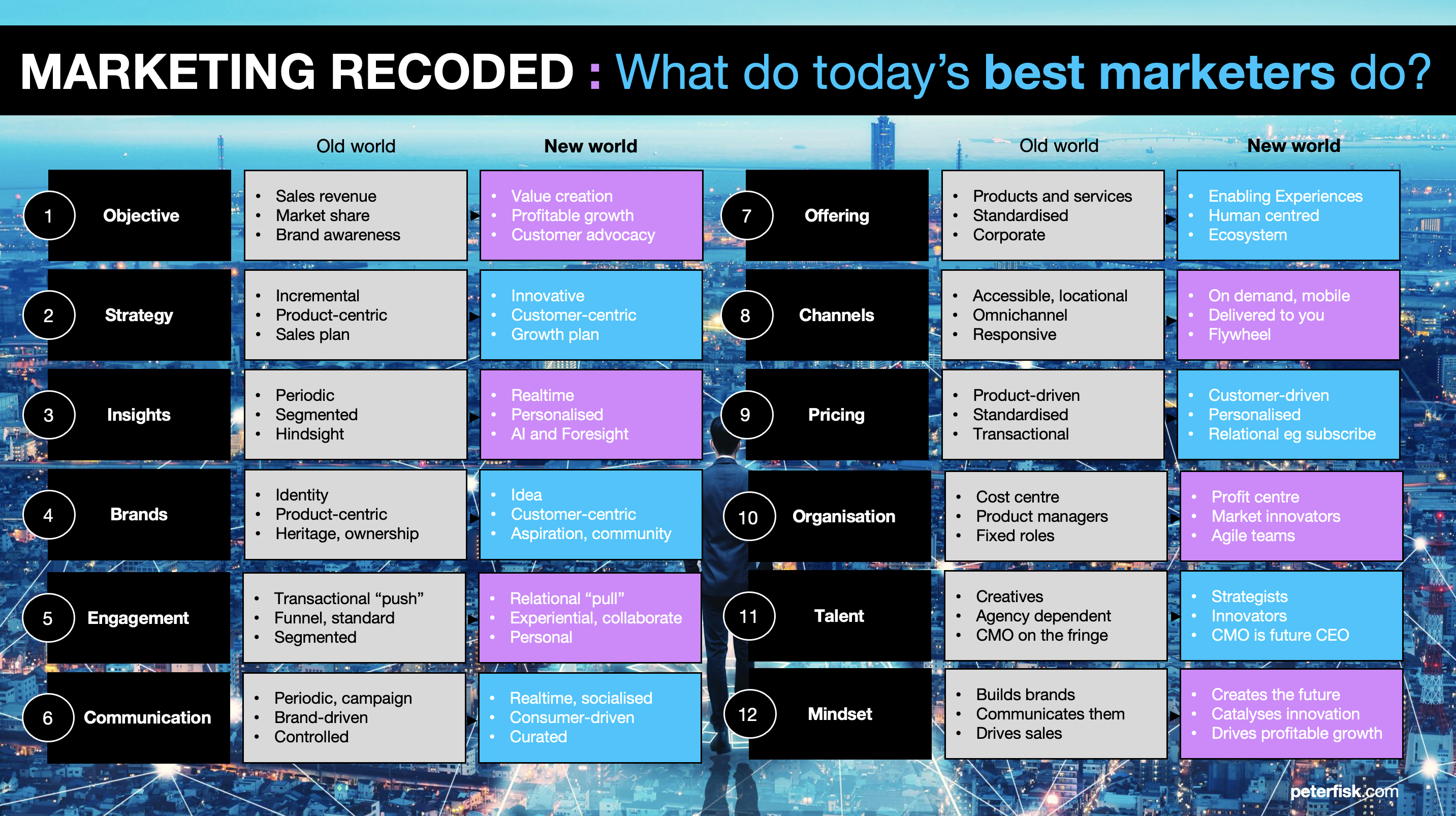
The best companies, traditional or new, interpret themselves not as product-centric but as customer-centric businesses. Of course, experts have being saying that for 40 years. Yet most companies still interpret customer-centric as “smiling faces” or “fast response”.
Instead, think about this. Do you define your brand around your business and product, or around the customer and application? …. Think about it … Don’t define yourself by what you do – you’re a food company, a sportswear company – but by what you enable people to do.
Nike is a sports company, not a sportswear company. Harley Davidson is not about the technically-mediocre motorbike, but about the freedom of the rider. Danone is not a food company, but a healthy living company.
And then everything else follows too – don’t focus on the sales transaction, the point of sale, advertising the product functionality, the price relative to production cost – think about what the customer seeks to achieve, how you can support them over time, engaging them in learning to use it better, and the price relative to the value they gain.
This is not rocket science. But it is still a wake-up to many marketers.
More strategically, it’s also about exploring what more you can do – don’t limit your growth to just finding more customers for existing products, or more products for existing customers – think about how you can go further – using your assets, capabilities and imagination in new ways.
Take PingAn for example. The Shenzhen-based insurance company is one of the largest in the world. It has a digital platform serving almost one billion customers. For boring insurance. What more could it do? It looked at where the growth opportunities are, the unexploited markets, and how its assets could help. Today, after just 4 years, Ping An is also the world’s largest healthcare platform.
What is the balance point between new technologies (for example, artificial intelligence) and the human component (contact with a “real person”)?
We are human. Real people. People trust people.
Technology is simply there to enable us to do better. AI, for example, helps us to anticipate and meet people’s needs better. Robotics helps us to improve the efficiency and accuracy of processes. Think of Kava robots in Amazon warehouses, or the Da Vinci robots which perform the majority of heart surgeries. Blockchain delivers solutions faster and cheaper.
We also need people to act in human ways – to interpret emotions, to engage with empathy, to build relationships, to share hopes and fears, purpose and passions.
If you are developing a new website, a new app, a new process for your business – think about this – how does it create a better experience – not just fast and efficiency, but more personal and human too. Similarly companies how seek “digital transformation” need to recognise that what they really need is “business transformation”, probably customer-centric, enabled by digital technology.
DBS is a great example of this. For the past 4 years, the Singapore business has been ranked the world’s most innovative bank. Their strategy is to “make banking invisible”.
They want people to “bank less, live more”. Their entire focus is on implementing better payment-related technologies into everyday life – shopping, entertaining, transporting, educating. They don’t want people to spend time coming to banks, or using separate apps for money, they want people to get on with life.
In line with the previous question and with a view to friction-free marketing, what do you consider to be the most appropriate customer journey for the short and medium term?
The biggest opportunity today is to become a C2C company. Customers connected to customers. Sharing their passions, supporting each other. Co-creating, co-selling, co-enabling what they do.
This is the best form of friction-free marketing. Where there is no company getting in the way. Of course, there is a brand – but the brand is about the customers, and their shared passion – not the company. The brand is more like a facilitator, helping customers to do what they want better.
Glossier is a great C2C example, created by Emily Weiss, and now one of the world’s fastest growing beauty brands. It is about customers sharing their love of beauty – including new ideas for products, recommending their best friends, and then sharing in the everyday use of the products.
Rapha is another great example. The cycling brand, which started in London with its first “cycle club”, which is a store but with a café in the centre, a bike store and workshop, and showers. Of course the store is where you can buy Rapha cyclewear, but more importantly it is where you meet people like you, to share your passion for cycling, to watch a race over a coffee, to go for a ride after work. Go on the Rapha app, its full of people sharing their love of cycling, as well as the products.
Given your extensive experience around the world, what are the most common mistakes that companies make when managing their brands in the face of new challenges?
It’s time to let go – let go of what made you successful in the past – and to explore and embrace, a different, and exciting, new future.
More on Marketing from Peter Fisk
- Agenda: Marketing’s New Agenda: Hot topics, tools and tips by Peter Fisk
- Book: “Marketing Genius: The left and right-brain of marketing” by Peter Fisk
- Book: “Brand Innovation” by Peter Fisk
- Book: “Gamechangers: Innovative strategies for brands and business” by Peter Fisk
- Article: The New Rules of Marketing by Peter Fisk
- Article: Building Brands like Pixar make Movies by Peter Fisk
- Article: “Market Makers: Developing a winning market strategy” by Peter Fisk
- Keynote: “Zoom in Zoom out: The future of marketing” by Peter Fisk
- Keynote: “The Magic Marketing Machine” by Peter Fisk
- Workshop: “Strategic Marketing: Winning in digital and realtime markets“ by Peter Fisk
- Workshop: “Genius Marketing: 21st Century Marketing Toolkit” by Peter Fisk
- Article: Reimagining Marketing by McKinsey
- Article: The Future of Marketing and Sales is Here by BCG
- Report: Global Marketing Trends 2022 by Deloitte
- Report: 15 Marketing Trends for 2022 by Forbes
- Report: CMO Survey Top Line 2022 by CMO Survey
- Report: CMO Leadership Vision 2022 by Gartner
- Article: Evolving Role of the CMO by eMarketer
- Article: 8 Skills of Future CMO by Blake Morgan
- Article: The Future of Marketing by Mathew Sweezey
- Article: The Offer You Cant Refuse by Steve van Bellegham
- Report: Brand Equity and Growth by Kantar
- Report: Social Media at the Cross Roadroads by MIT Summit
- Article: New Playbook for CMOs and Summary by CapGemini
- Report: Future 40 Technologies for Marketing by R3
Every market is shaken up, with new challengers and disruptive innovation, new agendas for customers and business. Marketers are the sense makers, the business innovators and growth drivers. The pioneers of your future business.
Consumer to consumer models are rapidly becoming the most effective marketing dynamics, social to superapps, collabs to communities. Brands are about people, their passions and communities, not about business and its products and services.
Markets have fundamentally changed
A new generation of businesses (new technologies, new business models, new leadership) is emerging to address a new generation of customers (new audiences, new geographies, new aspirations). Marketing exists to connect businesses and customers, in relevant and profitable ways.
A new approach to marketing is therefore required. Some of the new approaches, and maybe the language, will be familiar. But not all, and not joined up as a fundamental approach to driving business performance. Together, some call it Marketing 4.0 or Exponential Marketing, but whichever labels you apply, it involves a seismic shift in philosophy and practice.
It fundamentally challenges every marketer who still turns first to their strategic plan. And then to their advertising agency, or even their web developer. It is fundamentally digital in mindset, but human as well as technological. It demands analytical thinking, content and networks, but also vision and creativity. It requires new types of leaders, and a new mindset for every marketer. It is built around 7 transformations.
These are the new rules of marketing:
- Strategic Agility … Forget strategic planning that is slow, structured and stable – instead think of strategy like a portfolio of fast and relentless experiments, seizing and shaping the best opportunities for growth. It still needs direction and choices – a vision still matters, making sense of change, having a clarity purpose, and a defined context in which to hack. Strategy becomes agile and creative, outside in, big ideas and small experiments, driven by changing markets and customer aspirations, rather than fixed by your own capabilities and products.
- Customer Precision … Forget mass-market segmentation, whether geographic, demographic or anything else. People are individual, and don’t want standardised solutions. The power of big data, connecting and interpreting, automating and exploiting – together with more qualitative and creative insights through customer immersion and “design thinking” – is used to focus, engage, customise, deliver, support, enable the right customers over time. Linking to the agile culture, is the ability to keep learning, about people, about yourself, and what works.
- Market Innovation … Forget innovation around a product, or even a service. Think strategically about how you can shape the market, in particular the platform that engages buyers and sellers, suppliers and distributors. Business model innovation, channel innovation, price innovation, then follow. Innovation is about shaping the market and all its dynamics to your advantage, whilst also personalised for each individual through micro-innovation – collaborative and customised solutions and experiences.
- Purposeful Brands … Forget brands built around who you are – brand logos, slogans and ownership. People engage with brands about them, brands that reflect their aspirations, and brands that connect them with other people who share their values and aspirations. Brand stories are living fables, encouraged by the company, but interpreted and spread by people to people. Content must be realtime and relevant, and keep moving forwards. Encouraged but not controlled. Inspiring, human and memorable.
- Social Communities … Forget advertising, whether a TV campaign with 30 second slots, or even personalised mailings – people are not listening, and they don’t trust you. Instead they trust people like them, friends and peers. Word of mouth in a digital world, PR and celebrity endorsement is replaced by Instagramers or Youtubers who they trust. Brand stories, advocates, and community building help to guide and shape this influence.
- Enabling Experiences … Forget customer experiences as a semi-automated series of incentivised touchpoints built around the “sale”, think instead from a customer’s perspective. Think about the experience they have – the outcomes, not the inputs, what they do not what you do. Which is usually more about how they use, apply and exploit the products and services which they buy, rather than the purchase itself. Use their language, think about their experience, and how they use, store, apply and even dispose of products and services. Enable them to achieve more.
- Future Growth … Forget an obsession with sales volumes, even revenues, which are the short-term measure of sales people. Marketers should be focused on growing the business – profitably and sustainably – creating a better business future, and a long-term platform and guide for customers. Think profitably. Think growth. Think economic value creation. Exponential growth is now the expectation of investor, achieved by harnessing the power of branded networks, social influence and agile business models. Fast, exciting and rewarding.
These new rules of marketing, and specifically the 7 transformations, are the cornerstones of my next book and also of a new range of inspiring keynotes and practical workshops. We explore each mantra in detail, with detailed case studies together with the tools and partners for action.
Whilst of course, every market and every business is different, the 7 mantras are a provocative challenge for change. Of course, solutions are not black and white. Every business still has a mix of structured and hacked strategy, uses a box of earned and paid media, and has a balance of push and pull. But it is a rapidly changing area, a revolution.
Marketing is the driving force of business – it moves the business forwards, shapes the future, engages the customer and aligns the organisation to deliver. It is the growth engine, the innovation catalyst and customer champion. Markets are changing at incredible speed, requiring new agility and new capability.
There has never been a more exciting time for marketing, or to be a marketer.
Future shapers, business innovators and growth drivers
Marketers have a deep understanding of markets, how the future is emerging, what the customers of today and tomorrow are demanding, how competitors are evolving, the best new ideas around the world, and therefore what it will take to drive future innovation and growth. Yet only 11% of CEOs come from a marketing-related background, far behind those who were CFOs or COOs. Finance and operations matter, but they don’t move the organisation forwards.
Too many marketers get caught up in the tactics – perfecting the creative execution of advertising, debating the intricacies of price changes, ensuring that their search engine positioning is optimised, a slave to quarterly revenues, or maybe even the sales team. The driver for ever great data analytics, the use of precision marketing tools, the desire for real time engagement, has dragged – or enticed – marketing leaders into this short-term. Yes, it matters, but it’s not everything.
Marketers should be stepping up to drive strategy, innovation, and change across the organisation. If not them, then who?
One of the most profound moments of my own marketing career was when working with Coca Cola, their CMO had a last-minute idea to rebrand his global marketing plan as the global growth plan. Suddenly everyone in the executive team wanted to see it, read it, be part of it. Suddenly it became a conversation not about reducing the marketing budget, but how to find more budget to fund additional growth. Marketers are the growth drivers, and actually create over 3x more economic value than any other function in the business (based on a research project I did with Philip Kotler’s input and a team of economists). And marketers have some indispensable tools – brands, customers, innovation – to achieve this growth.
The problem is that too many marketers live in an echo chamber.
Some examples. Too many marketers talk about marketing as “their industry”. It’s not. They are instead professionals contributing towards their business in its own industry – banking, retail or whatever. This tribal motivation can bond us as a professional community, and focus us on functional deliverables, but it diverts us from the real contribution marketers can make to organisations, and their close allegiance and integration with cross-functional colleagues. The exception are the leaders and their teams who have repositioned themselves more holistically as Customer Director, Chief Growth Officer, and the like.
Secondly. Too many marketers have a far too cosy relationship with their creative agencies. It’s like they outsource their creativity to the agency, who still largely take a myopic view (of course, there are many types of agencies, but the ad agencies still tend to dominate relationships despite the diminishing share of spend on traditional media). Ad agencies themselves describe their world as “adland”, a mythical place of long lunches and artistic platitudes (witness the headlines in Campaign). This symbiotic relationship, indulgence in each other, is what holds too many marketers and their businesses back. Creative agencies should be stepping up to contribute more, to make sense of a changing world, to challenge and stretch our collective imaginations.
Too many marketers don’t step up to think strategically, to become the future shapers, the innovation drivers, the change makers. Too many marketers are still obsessed with communications, at the expense of other aspects of marketing – not just product and service development, but channels and pricing can have a huge impact too, perhaps even greater than the most beautifully crafted ad campaign.
Instead marketers should be the visionaries behind how the future can be shaped, how markets will evolve, anticipating and driving change rather than just responding. They should be searching the world for new growth opportunities, for new consumer insights, for more innovative ideas. They should be the architects of new business models, and indeed, new market models. New ways for markets to work, new ways to unlock brands as the most valuable assets, new ways to achieve success. They should be the driving force of business futures, the catalysts and sage to the business leader, the instigator and enabler of change.
In more detail, here is the shift we need to make:

Here’s my manifesto for marketers:
Growth Drivers
- Marketers exist to drive the growth of a business. Yet few marketers have the confidence, or maybe capability, to define and drive the holistic innovation and growth strategies of their organisations
- The pandemic drove the biggest shift in consumer behaviour in our lifetime, yet few marketers really transformed their marketing in response, fewer still led a company-wide response to support or seize the opportunities it opened up.
Change Makers
- Change is driven by markets, yet marketers are rarely the change drivers, reimagining corporate strategies, business models and strategic priorities.
- Customer-centricity is obvious. Yet marketers persist in obsessing about defining purpose, brands, activities and results around old product-centric thinking.
Business Innovators
- Innovation is probably the most powerful word in business, yet few marketers seek to define and lead the innovation agenda and programs across organisations. Not just new products, business-wide innovation.
- Most companies seek to be entrepreneurial. Their biggest disruption comes from entrepreneurs. Most entrepreneurs are marketers. Few marketers are entrepreneurial.
Value Creators
- Marketing creates three times more economic value than their operational colleagues, yet few marketers can make this case, or lead the company’s dialogue with investors. Oh, and growth needs to be profitable and sustainble too.
- Customers and brands are probably an organisation’s most valuable financial assets, yet few seek to articulate their value on balance sheets, or to fully exploit their latent potential.
Of course this is a development challenge too. I spend much of my time working on leadership development, and particularly on the T-Shaped development of functional experts as they step to become business leaders. At that point, typically when they enter the C-suite, they shift from the vertical (the focused, functional expert who has all the answers), to the horizontal (the open-mind business leader who asks all the questions). This is is a tough transition for many leaders to make, and is more about awareness and confidence as about capability or skill, but when they can let go of their vertical past, they can thrive.
Bringing together other perspectives on the future of marketing
Peter Fisk has over 30 years of marketing experience, from his first job as a brand manager in the airline industry, through many roles in developing marketing strategies for the likes of Adidas and Asahi, Cartier and Coca Cola, Mars and Microsoft, P&G and Pfizer, Santander and Suntory, Vestas and Virgin. In 2002 he became the CEO of the Chartered Institute of Marketing, with over 60,000 global members, member of the World Marketing Council, a fellow of the Marketing Society, and judge of the annual Marketing Excellence Awards. His bestselling book “Marketing Genius” has been translated into 35 languages, and explores “the left and right brain of marketing thinking, how to be the Einstein and Picasso of brands, combining intelligence and imagination”. He now leads GeniusWorks, a specialist market-driven innovation firm, and is a professor of strategy and leadership at IE Business School. His new book “Business Recoded” was reviewed by FT with “Wow, this is the book you have to read now!”
- Agenda: Marketing’s New Agenda: Hot topics, tools and tips by Peter Fisk
- Keynote: Marketing Recoded: Whats new and not in marketing by Peter Fisk
- Keynote: Friction Free Marketing: Every business can be a C2C business by Peter Fisk
- Book: “Marketing Genius: The left and right-brain of marketing” by Peter Fisk
- Book: “Brand Innovation” by Peter Fisk
- Book: “Gamechangers: Innovative strategies for brands and business” by Peter Fisk
- Article: The New Rules of Marketing by Peter Fisk
- Article: Building Brands like Pixar make Movies by Peter Fisk
- Article: “Market Makers: Developing a winning market strategy” by Peter Fisk
- Keynote: “Zoom in Zoom out: The future of marketing” by Peter Fisk
- Keynote: “The Magic Marketing Machine” by Peter Fisk
- Workshop: “Strategic Marketing: Winning in digital and realtime markets“ by Peter Fisk
- Workshop: “Genius Marketing: 21st Century Marketing Toolkit” by Peter Fisk
- Article: Reimagining Marketing by McKinsey
- Article: The Future of Marketing and Sales is Here by BCG
- Report: Global Marketing Trends 2022 by Deloitte
- Report: 15 Marketing Trends for 2022 by Forbes
- Report: CMO Survey Top Line 2022 by CMO Survey
- Report: CMO Leadership Vision 2022 by Gartner
- Article: Evolving Role of the CMO by eMarketer
- Article: 8 Skills of Future CMO by Blake Morgan
- Article: The Future of Marketing by Mathew Sweezey
- Article: The Offer You Cant Refuse by Steve van Bellegham
- Report: Brand Equity and Growth by Kantar
- Report: Social Media at the Cross Roadroads by MIT Summit
- Article: New Playbook for CMOs and Summary by CapGemini
- Report: Future 40 Technologies for Marketing by R3
How many everyday products have the power to change lives?
Books can.
While most publishers seek to maximise sales volumes by churning out as many titles, pages, and copies as possible – and then selling them at prices cheaper than a movie ticket – the best books can change how you see the world. They make you think, they educate, they entertain, they inspire. The best books empower you to change your life, and even those of others.
Sustainability is about much more than reducing your negative impact.
Yes absolutely, we need to reduce emissions, reduce transportation, reduce waste. And there is plenty of scope to do that in book publishing. Consider, for example, that around 40% of all books are returned unsold and pulped. Consider, for example, that many of these books are shipped around the world from cheapest print location to book store, and then back again. Consider for example, that many books are still made from unrecycled paper, printed with toxic inks, and bound with toxic glues.
Yes, absolutely we can do better. And indeed, when consumers, wake up to these bad practices, there will be huge pressure to transform. Just like in the energy or automotive sectors, the companies who are not thinking radically differently now, will be left far behind.
The real opportunity of sustainability is to enhance your positive impact.
Books can change lives. For people of every age, every walk of life, books educate and enable us to do better, but they also bring joy and happiness, and inspire new possibilities.
Actually, the content, more than the book.
Bringing together more diverse, more interesting authors. Addressing more important, crucial subjects. More personal, more topical, more accessible, more connected. Designing content in more engaging, applicable ways. Delivering content across multiple platforms to increase its reach, accessibility and usefulness.
If we think content first (or even better, audience first), then its relatively easy to see the opportunities for change, rather than being limited by our old lazy practices, and book-first prejudices.
Creating sustainable and profitable growth is the opportunity.
Sustainability used to be a compliance issue – and in some ways ESG metrics are little more than the CSR mantras of old. Today, sustainability is becoming core business. It’s at the heart of your competitive advantage, the key to your innovation and growth.
That’s because it has become a key demand and aspiration of the majority of customers. And employees. And investors. Sustainable businesses attract the best customers, who often pay more, typically around 25-50% more. (How much do you pay for organic food?). They attract the best talent, particularly young people. And more investment. (The world’s 100 most sustainable companies – led by Vestas, Autodesk, Schneider – outperform stock market averages by around 40%).
- Business Tools with Purpose, on sustainability, innovation, diversity and more
- Sustainability as Competitive Advantage, with keynotes, and workshops
- People Planet Profit, my book on sustainable innovation and growth
- Business for a Better World, spider silk and sizzling burgers
The opportunity is to be sustainable, and use that as the catalyst for innovation and growth. And to develop value propositions, and business models, which ensure that the growth is more profitable too. I would call this “good growth” – growth which profitable but not sustainable is not enough, but also growth that is sustainable but not profitable is not enough either. The “sweet spot” is do both, sustainable and profitable. That requires a new leadership mindset, disruptive innovation, and business transformation.
Coming together to create a better future. Future Book Forum 2022.
This year’s forum brought together publishers from over 30 countries, and many other partners in the book ecosystem. Organised by Canon, leaders in digital print technologies, it is the most thought-leading, practically collaborative, forum for publishing leaders. 10 years ago, I sat down with Canon’s Joerg Engelstaedter, and we asked ourselves how we could help this industry to change, innovate and grow. Over the last decade we have together explored all the big topics, from content and communities, sustainability and business models, to reimagining the entire DNA of a book.
Finding new opportunities for sustainable, profitable growth.
We started by looking beyond our own industry, to a world in which every business in every sector knows it needs to change. To reinvent itself in response to changing audiences and agendas. Sustainability is obviously one of the driving forces. However when you combine that challenge with the opportunities of new technologies, the growth of new markets, the different attitudes of GenZ, then radical change emerges. The entertainment world is now dominated by the likes of Epic Games, Netflix and Spotify. The automotive world is championed by EV pioneers like Tesla and Nio – where Toyota makes 10 times more cars, yet Tesla is 10 times more valuable. And BMW and Volkswagen now wish they had changed 10 years ago.
Adidas has transformed its business through purpose and sustainability.
Matthias Rippel, Adidas Global Director of Brand Strategy, joined us to talk about how Adidas rose to the challenge and opportunity of sustainability. Adidas, by coincidence has a purpose statement, remarkably similar to books – “through sport we can change lives” – the only difference is the product. 2015 was a seminal year for the global sportswear business, when it joined forces with Parley to address the challenge of ocean plastic waste – and creating a new range of premium-priced shoes made from the recycled waste. It changed mindsets, and demonstrated new ways in which they could compete, innovate and grow.
Since then, Adidas has worked to find new materials – for example working with Bolt Threads to create Mylo, a form of “vegan” leather. Every pair of Adidas Stan Smith’s will now be made from mushrooms. They also collaborated with their most sustainable competitors like Allbirds to achieve more together, creating the new Futurecraft Footprint which has a total carbon footprint of just 2.93kg (written on the sole), almost 10 times less than normal. Just this week Adidas launch “Run for the Oceans” where over 5 million people signed up in the first days to take part – for every 10 minutes they run, Adidas recycle the equivalent of a plastic bottle of waste.
As Canvas8’s social scientist Jemima Cox said “Make it simple. Make it positive. Make it desirable.”
Growth Accelerator: Finding “good growth” in book publishing.
At the heart of each year’s Future Book Forum is practical, innovative action. This year’s Growth Accelerator saw 10 teams of industry leaders explore what “good growth vs bad growth” really means for the future of publishing. First they explored ways in which book publishers could reduce negative impacts across each aspect of the value chain, and then how to enhance the positive impacts.
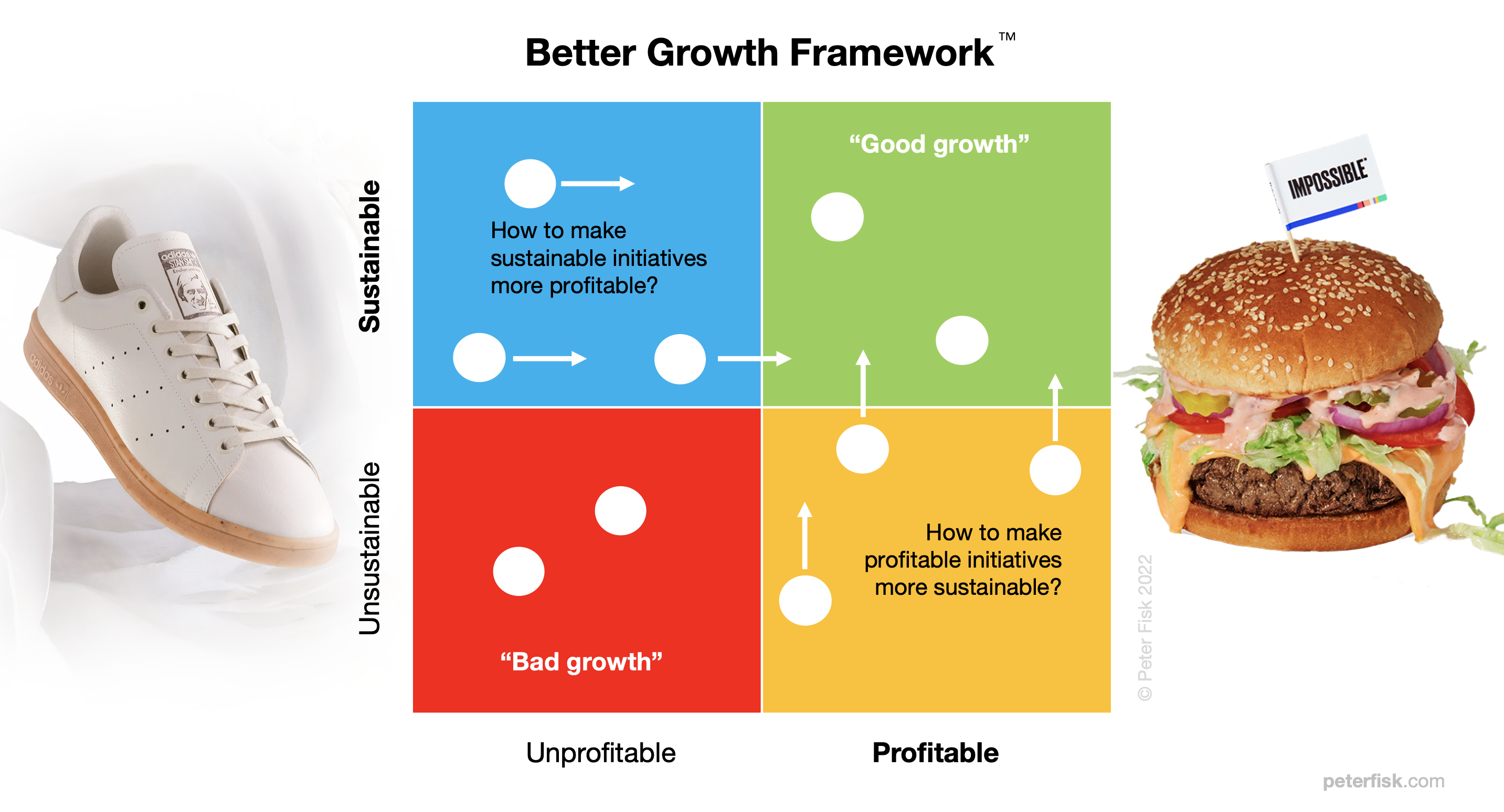
The real opportunity was then to explore initiatives which could both be sustainable and profitable for book publishers – either by taking sustainability challenges (like addressing excessive waste from returned orders, or paper usage, or toxic pollutants) and innovatively rethinking the business model – or by focusing on the key profit drivers (such as blockbuster authors) and thinking how to sustainably do more with them (for example, through innovative use of content across platforms, personalised storytelling, and focusing on key issues).
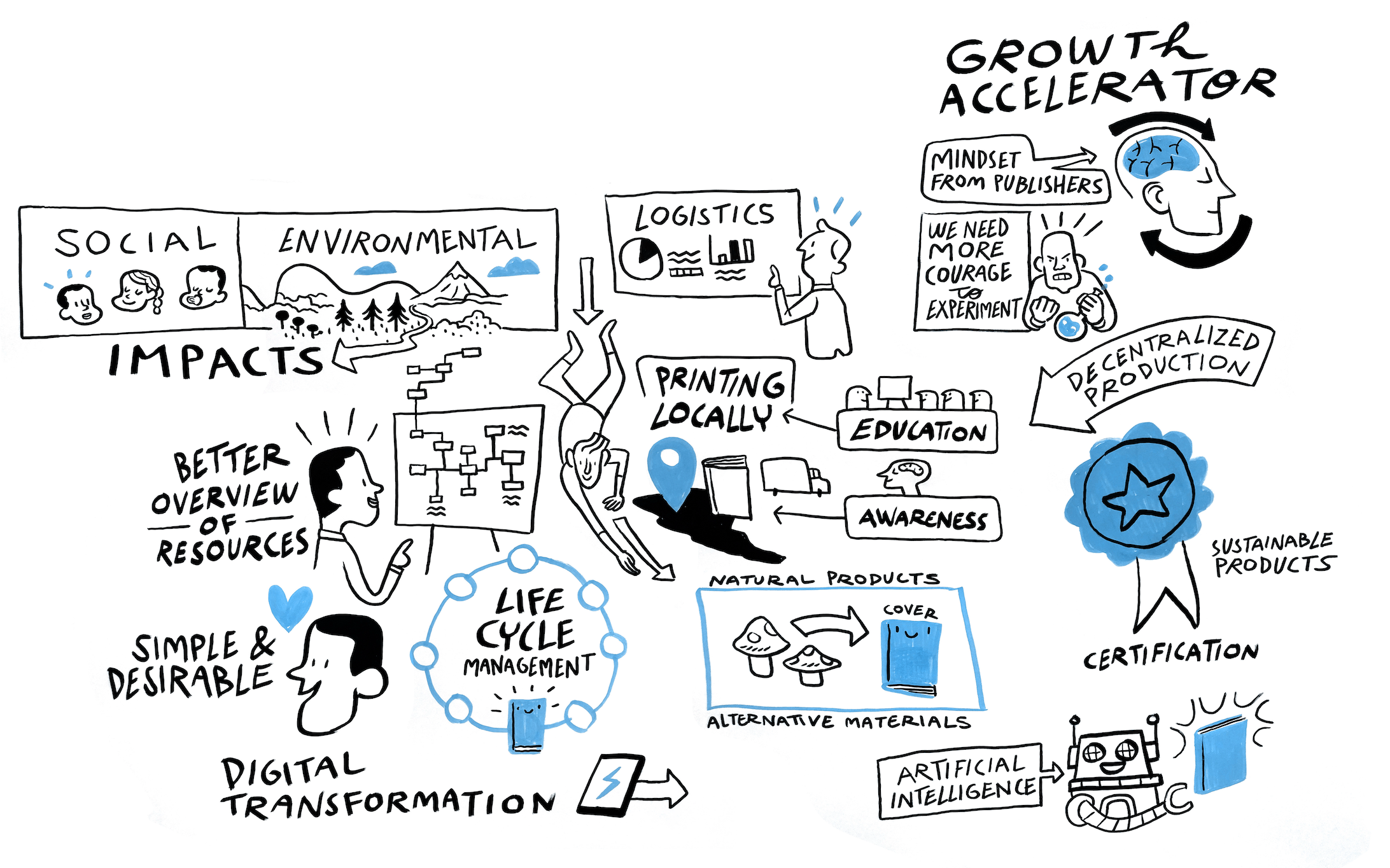
Key opportunities for “good growth” which publishing industry leaders chose to focus on included
- Harnessing the power of storytelling as a way to inspire people to explore and address key sustainability issues, in more engaging, motivating and practical ways.
- Addressing big issues, bringing together more diverse audiences, and using social aggregation platforms to create collective thinking, responses as big problem solving.
- Better data analytics to forecast sales opportunities, and then “print on demand” to achieve smaller order sizes, or respond to customers as required.
- Distributed production, to enable this print on demand functionality anywhere in the world, through networks of printers, and avoid excessive transportation.
- Addressing big issues, bringing together more diverse audiences, and using social aggregation platforms to create collective thinking, responses as big problem solving.
- Personalised content, which could be user-generated, and used across platforms, in more valuable and applied ways – building on the success of photobooks and greeting cards.
- Building a pre-loved marketplace of second hand books, and also utilising the backlist of older titles which can easily be printed on demand.
- Eliminating book returns, changing the industry practice of accepting unsold books back from retailers, which are typically then pulped
- Reducing the amount of physical sales visits, the number of inspection copies sent out, and instead harnessing digital marketing, social influencers, and new platforms.
- Eliminating the use of toxic inks and glues in the production of books, and particularly handbook formats, and being more open to content-first hybrid versions, rather than print first.
- Enabling customers to achieve more themselves – creating networks or communities of readers who can take book ideas into practice collectively, and apply their impact.
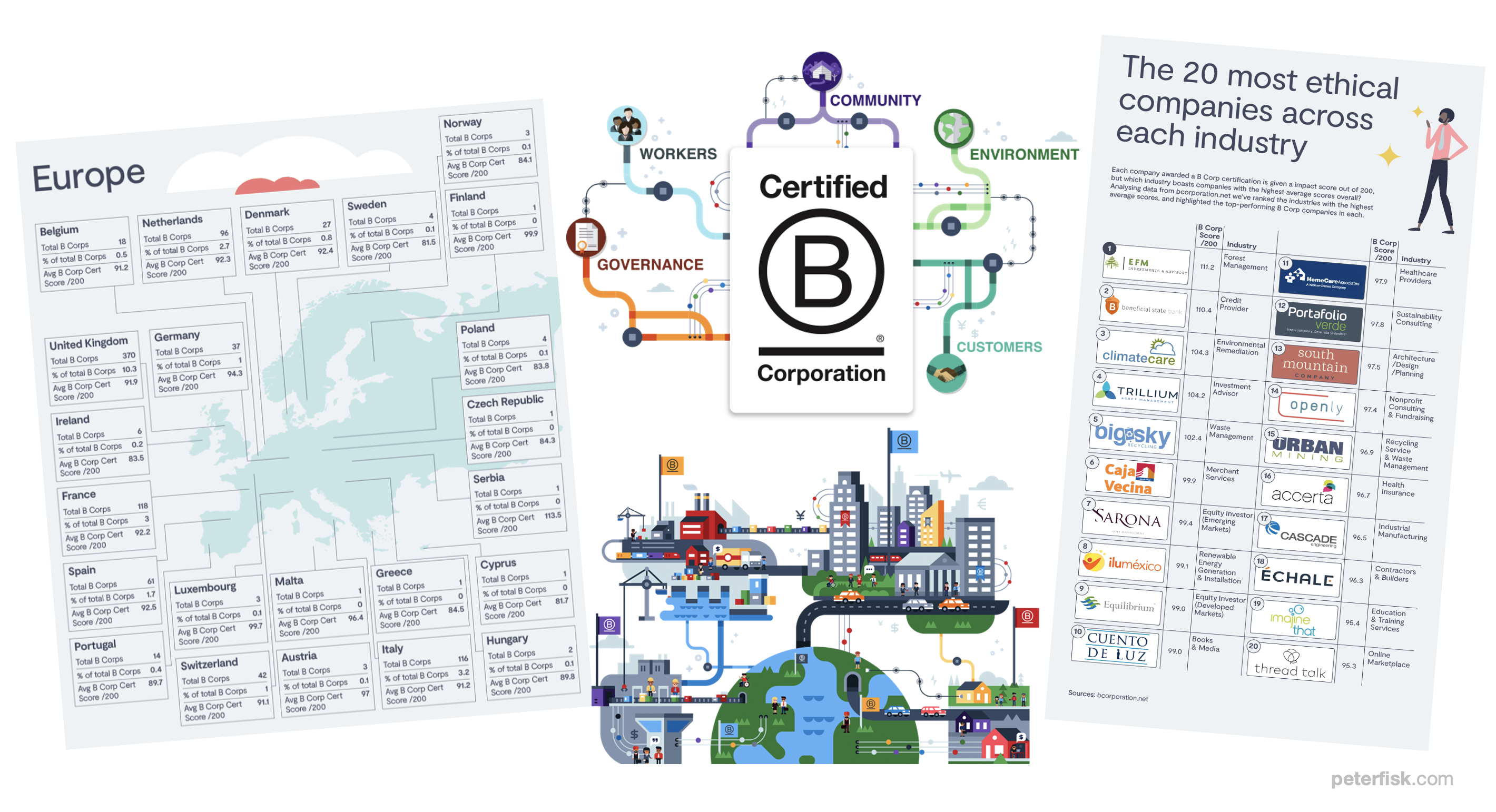
One of the most effective frameworks for developing a sustainable business is the B Corp assessment and certification model, which also provides a useful, comprehensive benchmarking model. It identifies global leaders in every industry. Cuento de Luz, the wonderful small publisher developed by Spain’s Ana Eulate, is the world’s most sustainable book publisher. She says “stories that take the imagination on a journey, care for our planet, respect differences, promote peace.”
- Business Tools with Purpose, on sustainability, innovation, growth
- Sustainability as Competitive Advantage, with keynotes, and workshops
- People Planet Profit, my book on sustainable innovation and growth
- Business for a Better World, spider silk and sizzling burgers
Bringing this all together, we launched a new initiative, Publishing 2030, which seeks to build a collaborative approach to more sustainable, profitable book publishing. This will include the development of a manifesto for better books, and become an initiative in which all participants in the Future Book Forum community can participate. The progress will be tracked in the next forums.
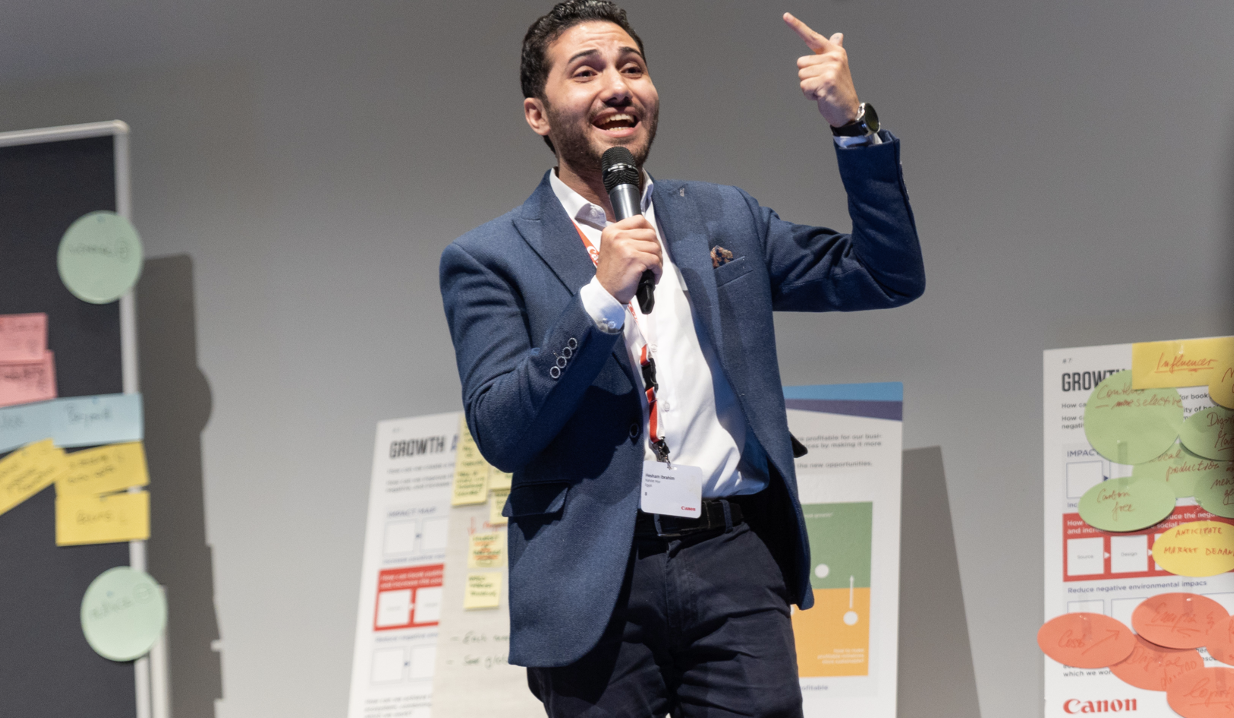
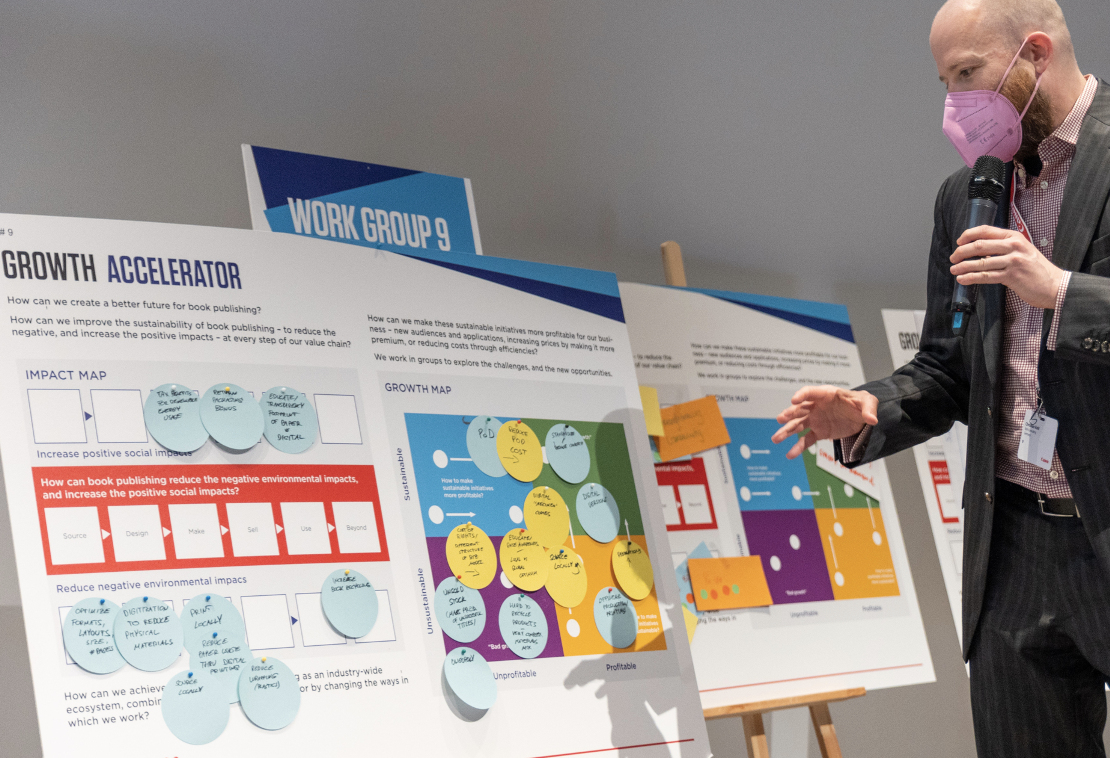
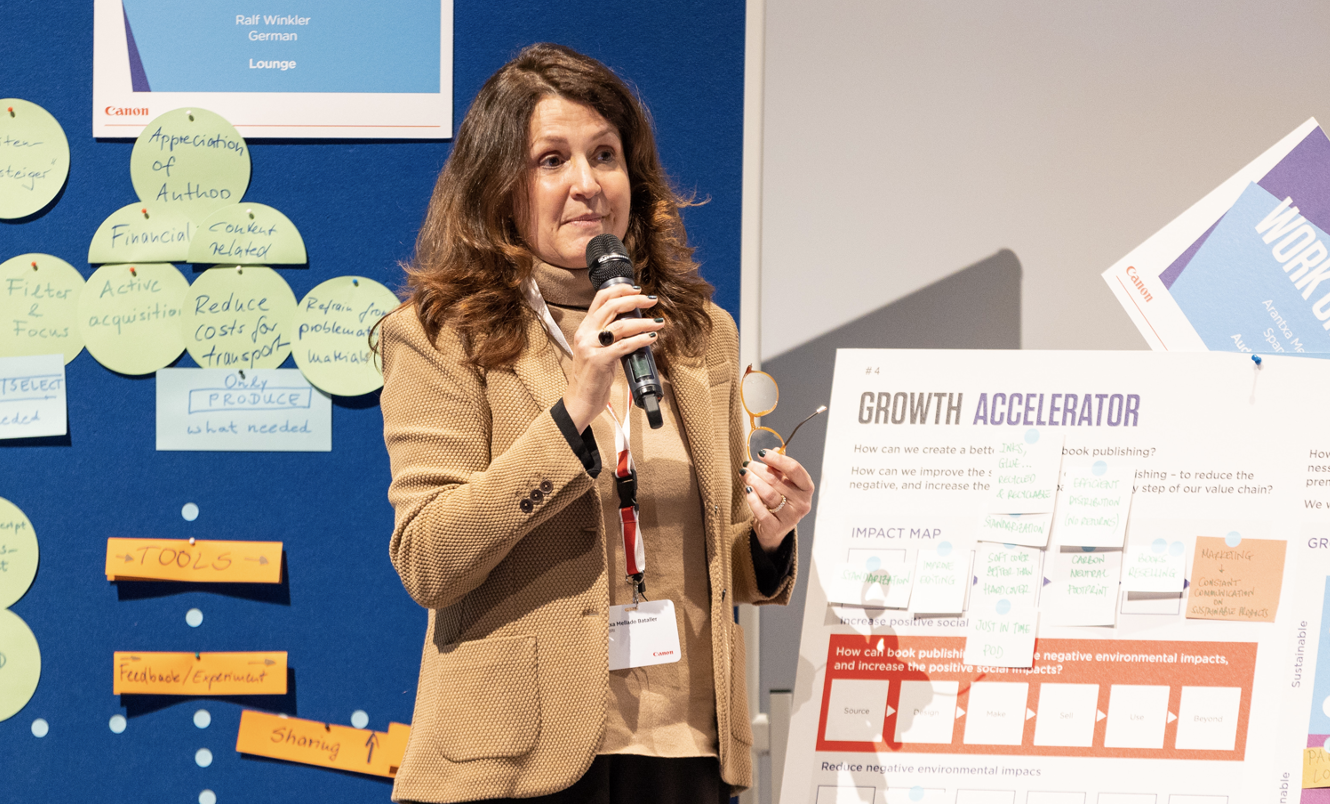
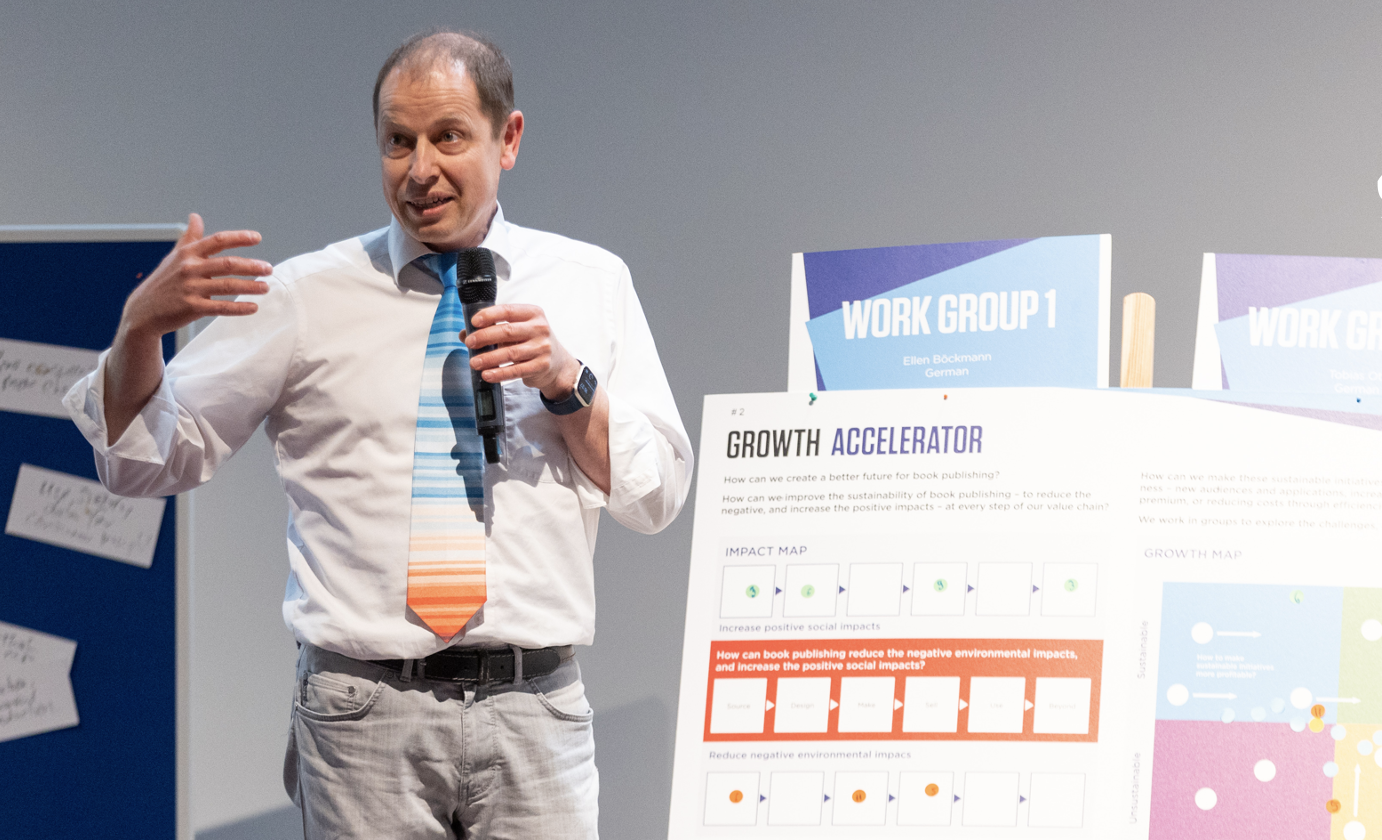
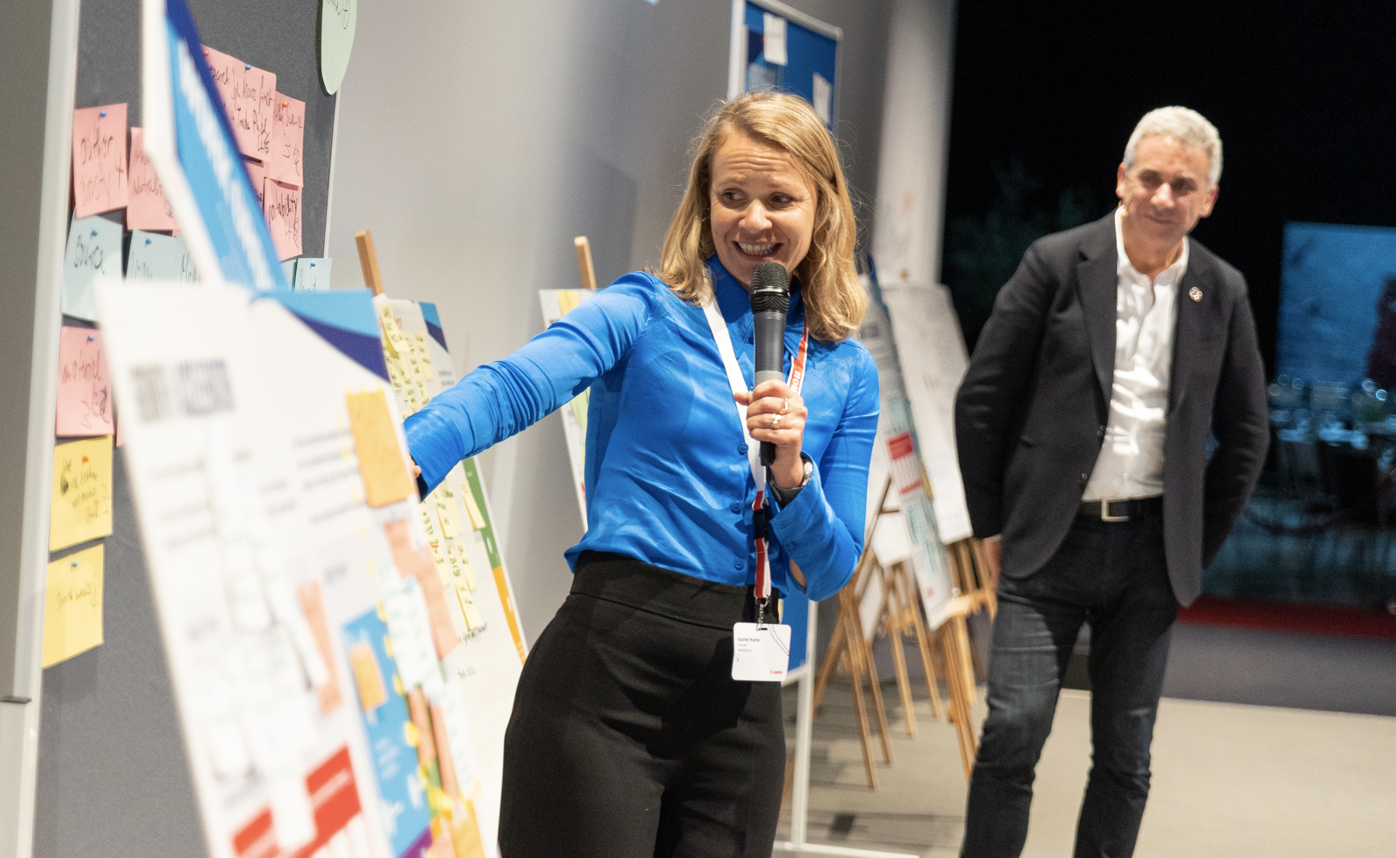
- Can we predict the “irrational” behaviour of customers?
- What drives preference, desire and loyalty to brands in today’s connected world?
- How do we rebuild corporate trust and reputation in society?
- Why are GenZ rejecting corporate employment in record numbers?
- How can we design jobs to be more inspiring, enriching, and productive?
- What creates psychological “safety” in high performance teams?
- How do you “nudge” customers to change behaviours?
- Why would people choose the same product but when it is 10 times more expensive?
- How does storytelling change the way you explain strategies to investors?
- What creates the “flow” state of heightened performance, when working intensely?
The business world thrives on technological innovations and operational efficiencies, but it is also intensely human. And as machines free people from processes, customers become more diverse and discerning, and creativity drives competitive advantage, then harnessing the potential of humanity matters more than ever.
In my new book Business Recoded, I focus on the world of being “more human” in a world of technology and change. This demands that leaders increasingly become the business pyschologists – how to really understand what makes people tick, how to engage and influence them effectively.
And it’s not just about employees, and how they more effectively work inside the organisation – its equally about customers and how to influence them (look at the growth of “behavioural economics” over recent years), crucially about investors and how they interpret value potential in a complex uncertain world, and most profoundly about society and how they perceive business in world where agendas such as climate and inequality, fairness and geopolitics, can seem at odds with the pursuit of profits and growth.
As a result “Brain Business” has become a useful and practical approach to applying psychology principles in all aspects of business, from strategic thinking and leadership development, to brand propositions and everyday work.
The Business Pyschologist
Today, every business leaders needs to become an expert at understanding and influencing human motivations and behaviours. There are many dimensions and components to this.
Daniel Goleman gave us emotional intelligence, where “EQ beats IQ” in developing employee behaviour, while Malcolm Gladwell’s Tipping Point explained how ideas spread. Dan Ariely has helped reinvent customer propositions like Lemonade Insurance, while Richard Thaler taught us how to “nudge” customers into new behaviours. Freakonomics showed us just how unexpectedly markets behave, and success emerges.
Business applications of psychology have tended to focus on internal work behaviours – known as IO, or industrial and organisational psychology in the States, or occupational psychology in the UK, or in other places WO, work and organisational psychology. Yet the biggest non-articulation has been on customer behaviour, for example understand seemingly irrational behaviours, and how to influence them.
Areas which have yet to be explored, from a psychological perspective, lie in the attitudes and behaviours of investors – from private equity to stock markets, how they perceive the value of business ideas and strategies, how they balance risk and opportunity, and therefore drive trillions of dollars impact. Equally, in society at large, how we perceive corporations, and their negative and positive impacts on our broader world.
Freak Behaviours
Freakonomics by Stephen Dubner and Steven Levitt has sold over 4 million copies. Incentives have been dangled in front of your nose all of your life. From “if you finish your plate you’ll get some pudding” as a child to “if you sell 100 cars this quarter you’ll get a 25% bonus” all the way to “if you don’t stop harassing the cleaning lady, we’ll put you in a home, grandpa!”
An incentive is meant to get you to do more of a good thing or less of a bad thing, and is used by anyone who tries to influence your behaviour. They say there are three kinds of incentives: Economic – usually involving gain or loss of time and/or money. Social – when chances are you’ll look good in front of your peers or be isolated from them. Moral – appealing to your conscience and inner drive to do the right thing.
The more types of incentives are combined, the more powerful the incentive gets. For example, the disincentive (a negative incentive, the stick from the carrot and stick approach!) to commit a crime is pretty strong. You could lose your job, house and personal freedom (economic), it is one of the most morally reprehensible things you can do (moral) and of course, you’d lose your friends and your reputation would go down the drain (social).
Growth Mindsets
Concepts like the Growth Mindset, have been adapted from other fields, and are now increasingly common and incredibly powerful in driving business behaviours and performance.
When Carol Dweck was a graduate student in the early 1970s, she began to study how children cope with failure, she quickly realised that cope was the wrong word, they realised. Now a psychology professor at Stanford, she has spent several decades studying this dichotomy which she initially termed “incremental theory”. She eventually found a better language – the “fixed” and “growth” mindset. Her book Mindset: The New Psychology of Success became a bestseller.
Dweck applies the concept to every walk of life – from children’s education and parenting, to sports coaching and mental performance. She argues that a growth mindset leads to higher achievement, whilst a fixed mindset actively plateaus an individual’s progress. She also applies the idea to teams and organisations. Those who for example, like to single out star performers are more fixed in their mindsets, rather than embracing everyone with their different contributions over time.
Psychology starters
Just as starters, here are 5 simple and well known psychological theories that every leader should know, essential to understanding the fragile yet complex minds of human beings, and to influence better performance and collective success:
- The Hawthorne Effect … being observed leads to higher productivity, employees are more motivated to work harder when more attention is paid to them, be it in feedback, collaboration or rewards.
- Maslow’s Hierarchy of Needs ... starting from the basic human needs, once these are satisfied, you can influence people in more intangible, emotional ways – from belonging to self actualisation.
- Authentic Self-Expression … the secret to making employees happy is by encouraging self-expression and letting new employees bring their unique values and perspectives to the job.
- Herzberg’s Motivation-Hygiene Theory … job satisfaction and dissatisfaction are not opposites; satisfaction comes from higher-level factors like recognition and autonomy; dissatisfaction is about lack of basics.
- Group Think … the search for harmony and conformity leads people to not innovate and not express their true opinions; which usually leads to poor decisions being made.
They are the easy ones, familiar to most people with a foundation in understanding people. But the topics go much deeper. To stretch your thinking a little more, here are some of my favourite books on these topics:
12 Great Books on Psychology for Business
Atomic Habits, by James Clear
How to change your habits and get 1% better every day. If you’re having trouble changing your habits, the problem isn’t you. The problem is your system. Bad habits repeat themselves not because you don’t want to change but because you have the wrong system for change. This is one of the core philosophies of Atomic Habits: You do not rise to the level of your goals. You fall to the level of your systems. In this book, you’ll get a proven plan that can take you to new heights.
Blink, by Malcolm Gladwell
The power of thinking without thinking. Intuition is not some magical property that arises unbidden from the depths of our mind. It is a product of long hours and intelligent design, of meaningful work environments, and particular rules and principles. The Canadian journalist, who can still run a mile in under 5 minutes (that impresses me!), explores how the power of blink could fundamentally transform our relationships – the way we consume, create and communicate, how we run our businesses, and even our societies.
Made to Stick, by Chip and Dan Heath
Why do disproved urban legends persist? How do you keep letting newspapers and clickbait sites lure you in with their headlines? And why do you remember complicated stories but not complicated facts? Over ten years of study, Chip and Dan Heath have discovered how we latch on to information hooks. Packed full of case histories and incredible anecdotes, it shows how an Australian scientist convinced the world he’d discovered the cause of stomach ulcers by drinking a glass filled with bacteria; how a gifted sports reporter got people to watch a football match by showing them the outside of the stadium; how pitches like ‘Jaws on a spaceship’ (Alien) and ‘Die Hard on a bus’ (Speed) convince movie execs to invest gigantic sums even when they know nothing else about the project. By demonstrating strategies like the ‘Velcro Theory of Memory’ and ‘curiosity gaps’, the book offers superbly practical insights.
Contagious, by Jonah Berger
Why do ideas catch on, and others don’t? Why does some online content go viral? Word of mouth makes products, ideas, and behaviors catch on. It’s more influential than advertising and far more effective. Can you create word of mouth for your product or idea? According to Berger, you can. Whether you operate a neighborhood restaurant, a corporation with hundreds of employees, or are running for a local office for the first time, the steps that can help your product or idea become viral are the same.
Drive, by Dan Pink
Drive explains the secret to high performance and satisfaction in today’s world is the deeply human need to direct our own lives, to learn and create new things, and to do better by ourselves and the world. To motivate employees who work beyond basic tasks, Pink argues that supporting employees in the following three areas will result in increased performance and satisfaction: Autonomy — Our desire to be self directed. It increases engagement over compliance. Mastery — The urge to get better skilled. Purpose — The desire to do something that has meaning and is important. Businesses that only focus on profits without valuing purpose will end up with poor customer service and unhappy employees
Emotional Intelligence, Daniel Goleman
Does IQ define our destiny? Goleman argues that our view of human intelligence is far too narrow. It is not our IQ, but our emotional intelligence that plays a major role in thought, decision-making and individual success. Self-awareness, impulse control, persistence, motivation, empathy and social deftness: all are qualities that mark people who excel, whose relationships flourish, who can navigate difficult conversations, who become stars in the workplace.
Freakonomics, by Stephen Dubner and Steven Levitt
At its roots, economics is simply the study of incentives. It’s all about how we use our limited resources in an attempt to satisfy our unlimited wants and needs. It’s about the trade-offs we make each day. For example, we’re incentivised to go to work and trade our time (limited resource) to get money to buy the things we want. When we’re a toddler, we’re curious to see what’s going on up there on the stove so we reach up and touch it, but when we get burned we’re incentivised not to touch it again. Our parents praising us for a good score in our 4th grade maths test is an incentive to do some extra homework the night before the test.
Give and Take, by Adam Grant
Everybody knows that hard work, luck and talent each plays a role in our working lives. Grant focuses on the importance of a fourth, increasingly critical factor – that the best way to get to the top is to focus on bringing others with you. Give and Take changes our fundamental understanding of why we succeed, offering a new model for our relationships with colleagues, clients and competitors. Using his own cutting-edge research as a professor at Wharton Business School, as well as success stories from Hollywood to history, Grant shows that nice guys need not finish last. He demonstrates how smart givers avoid becoming doormats, and why this kind of success has the power to transform not just individuals and groups, but entire organisations and communities.
Mindset, by Carol Dweck
Dweck explains why it’s not just our abilities and talent that bring us success-but whether we approach them with a fixed or growth mindset. She makes clear why praising intelligence and ability doesn’t foster self-esteem and lead to accomplishment, but may actually jeopardize success. With the right mindset, we can motivate our kids and help them to raise their grades, as well as reach our own goals-personal and professional. She reveals what all great parents, teachers, CEOs, and athletes already know: how a simple idea about the brain can create a love of learning and a resilience that is the basis of great accomplishment in every area.
Nudge, by Richard Thaler
Every day we make decisions: about the things that we buy or the meals we eat; about the investments we make or our children’s health and education; even the causes that we champion or the planet itself. Unfortunately, we often choose poorly. We are all susceptible to biases that can lead us to make bad decisions that make us poorer, less healthy and less happy. And, no choice is ever presented to us in a neutral way. By knowing how people think, we can make it easier for them to choose what is best for them, their families and society.
Predictably Irrational, by Dan Ariely
Why do smart people make irrational decisions every day? The answers will surprise you. Predictably Irrational is an intriguing, witty and utterly original look at why we all make illogical decisions. Why can a 50p aspirin do what a 5p aspirin can’t? If an item is “free” it must be a bargain, right? Why is everything relative, even when it shouldn’t be? How do our expectations influence our actual opinions and decisions? Behavioural economist Dan Ariely cuts to the heart of our strange behaviour, demonstrating how irrationality often supplants rational thought and that the reason for this is embedded in the very structure of our minds.
The Power of Habit, by Charles Duhigg
Why do some people and companies struggle to change, despite years of trying, while others seem to remake themselves overnight? Duhigg visits laboratories where neuroscientists explore how habits work and where, exactly, they reside in our brains. And he uncovers how the right habits were crucial to the success of Olympic swimmer Michael Phelps, Starbucks CEO Howard Schultz, and civil-rights hero Martin Luther King. He argues that the key to exercising regularly, losing weight, raising exceptional children, becoming more productive or even building revolutionary companies is understanding how habits work. By harnessing this science, we can transform our businesses, our communities, and our lives.
Thinking Fast and Slow, by Daniel Kahneman
Why is there more chance we’ll believe something if it’s in a bold type face? Why are judges more likely to deny parole before lunch? Why do we assume a good-looking person will be more competent? The answer lies in the two ways we make choices: fast, intuitive thinking, and slow, rational thinking. Kahneman reveals how our minds are tripped up by error and prejudice (even when we think we are being logical), and gives you practical techniques for slower, smarter thinking. It will enable to you make better decisions at work, at home, and in everything you do.
Find out more, and for keynotes and workshops, by emailing me at peterfisk@peterfisk.com
It’s easy to think of the over 60s consumer as old … white-haired grandparents, slowing down, retired from work, declining health, drinking cups of tea, gazing into the sunset.
In 35 years of marketing, it constantly annoys me that most marketers – particularly ad agencies, and therefore the clients and brands they work with – are largely uninterested in this market. Most creative outputs focus on youthful audiences – look in any fashion store, travel brochure, supermarket – youth is sexy, aspirational.
Young creatives identify with their own, inevitably, and lazily.
We all know that older consumers have most of the money. And are also the growth market. And they are certainly not the “old grannies” of our prejudiced stereotypes. Perhaps, my 35 years gives you a clue to my outrage. 60 years old does not seem so far away!
A few weeks ago I watched Sting on his current world tour. The Police frontman, global rock star, leather pants and bass guitar, looked and sounded better than ever. Having just celebrated his 70th birthday.
Tom Cruise turns 60 this year. There is still no mission impossible beyond him. So does Demi Moore. Think about Barack Obama shooting basketball hoops, Madonna still singing and gyrating to her erotica, or George Clooney, or Kim Cattrall, or Bono walking on stage to front U2. Julianne Moore, Colin Firth, Christie Brinkley, Jeff Goldblum, Denzel Washington. All over 60.
Perhaps we should stop thinking of age.
“Stage (Not Age)” is a new book focused on this $22 trillion opportunity, which Susan Golden argues can be unlocked only if you rethink everything you think you know about people over 60.
“In the time it takes you to read this, another 20 Americans will turn 65. 10,000 people a day are crossing that threshold, and that number will continue to grow. In 15 years, Americans aged 65 and over will outnumber those under age 18.”
Across the world, nations are getting older. My recent research into “megatrends” indicates a 40% increase in the number of over 60s by 2030. Think of the implications for everything from pensions to healthcare. Think about the opportunities for leisure, travel, entertainment, work, nutrition and so much more.
“Nearly everywhere in the world, people over 60 are the fastest-growing age group. Longevity presents an opportunity that companies need to develop a strategy for.”
Estimates put the global market for this demographic at a whopping $22 trillion across every industry you can imagine. “Entertainment, travel, education, health care, housing, transportation, consumer goods and services, product design, tech, financial services, and many others will benefit, but only if marketers unlearn what they think they know about this growing population.”
The key is to stop thinking of older adults as one market.
Like every demographic, over 60s are a deeply diverse population. “They’re traveling through different life stages and therefore want and need different products and services” says Golden.
We need to reset our understanding of what an “old person” is. To consider the diverse attitudes and behaviours, needs and wants involved.

Source: Wavemaker
The ageing population is most significant in Asia, with longer lifespans and declining birthrates. A recent article in Campaign Asia focused on the opportunities of the Over 60s market in Asia, saying “Marketers need to wake up to their spending power, and that they are just as dynamic as younger shoppers.”
“By 2050, one in four people in China will be aged over 65. Japan is already the oldest society on earth with a quarter of the population over 65, set to rise to 40 percent by 2060. The Japanese are ageing in such numbers, in fact, that the government has categorised those aged 65 and above as “pre-old”, 75-plus as “old”, and the over-85s as “very old”.
“Hong Kong, South Korea and Thailand also have a rapidly shrinking share of working-age population, and the UN predicts that in the next 30 years, the number of people aged over 60 in Asia will increase dramatically from 11 percent of the total population to over a quarter.”
“There is no doubt that this is the largest, fastest-growing, wealthiest segment of population in most developed markets of the world,” says marketing consultancy Silver Group. “And in Asia-Pacific, 54% of high-net-worth individuals are over 56 years of age, according to Cap Gemini and Merrill Lynch.”
Nielsen says ‘baby boomers’ in the US spend close to half of all FMCG dollars, yet less than 5% of advertising is geared towards them.
- During the pandemic, JD, China’s second-largest ecommerce platform, realized that senior consumers consumed 51%+ cosmetics over the same period last year.
- On Alibaba-owned Alipay, the leading online payment and finance platform in China, the number of elderly users in has doubled 4.5 times over the past 3 years.
- 36.7% of the users on Meituan, China’s largest online-to-offline platforms providing food delivery, travel, entertainment services, were born in the 1960s.
Mintel says “there is the assumption that over 60s tend to live life the old-fashioned way, without aspiration.” In China, Mintel’s research found that after spending on health, almost half of consumers aged 55 to 74 said they wanted to spend money on being entertained and on social events. They also wanted to spend more time travelling than shopping.
However, Mintel found the majority of brands currently targeting China’s 55-plus age group fell into categories such as dairy products (particularly milk formula), cereals, or hot beverages.
As well as positivity, consumers aged over 60 also crave authenticity. “Older consumers are the most experienced consumers. After all, they’ve been sold to for longer. As a result, they tend to see beyond the ‘cheap tricks’ of marketing and look for genuine value in brands.
One brand doing well in engaging with older consumers is L’Oréal, with its use of authentic and popular older models, such as (70 year old!) Helen Mirren, and age-friendly taglines like: ‘We’ve still got it, and we’re still worth it’. Another successful brand launch was the contemporary-looking Sixties’ Bamboo Charcoal Toothpaste, which was reformulated and designed for senior consumers in China, marketing specific benefits for the older age group.
Reebok also made headlines when it appointed 80-year-old actor Wang Deshun as its brand ambassador in China. Wang also stars in Reebok’s latest Chinese video campaign ‘Be more human’. Apparently Wang only got into sport in his 60s and is an example to prove that people are never too old to pursue their goals.
More
- “Stage (Not Age): How to Understand and Serve People Over 60” by Susan Golden, HBR Press
- “Over 60s – the next big growth opportunity hiding in plain sight” by WaveMaker
- “Shattering the over-60 stereotype” by Campaign Asia
New: Value Creation in the Metaverse, by McKinsey.
$54 billion per year is currently spent on virtual goods, almost double the amount spent buying music, says a new report, that goes beyond the hype to explore the real business potential of what we interchangeably term Web3 and the metaverse. Another report, by Meta Platforms, suggests that overall, the metaverse could be a $3 trillion opportunity for business by 2031.
JP Morgan’s new report on “Opportunities in the Metaverse: How businesses can explore the metaverse and navigate the hype vs. reality” argues that “the elements of a new digital age are converging at scale” and that “the metaverse is the driving force bringing these elements together in a unified, immersive experience.”
First some definitions, as amidst all the jargon and hype, it’s not easy to understand what we are actually talking about.
“In the simplest terms, the metaverse is the internet, but in 3D,” says Deloitte. “It’s a form of digital interaction where connected, virtual experiences can either simulate the real world or imagine worlds beyond it. Many of the metaverse ingredients are with us now – think interacting with lots of people and content made by them, in persistent, immersive worlds across many devices, including virtual reality. The more these components intertwine, the closer we get to a fuller version of the metaverse.”
“Many of the metaverse ingredients are with us now – think interacting with lots of people and content made by them, in persistent, immersive worlds across many devices, including virtual reality. The more these components intertwine, the closer we get to a fuller version of the metaverse
JP Morgan’s definition goes further: “The metaverse is a seamless convergence of our physical and digital lives, creating a unified, virtual community where we can work, play, relax, transact and socialize. The metaverse is still early in its evolution, and there is no singular, all-encompassing definition to which people can turn. Themes of what the metaverse is and could be, however, are emerging. A key point is that there is no one virtual world but many worlds, which are taking shape to enable people to deepen and extend social interactions digitally. This is done by adding an immersive, three-dimensional layer to the web, creating more authentic and natural experiences. The metaverse even has the promise of facilitating accessibility from the comfort of the home, breaking down boundaries and democratizing access to key goods, services and experiences.
Before diving deeper into the metaverse, it’s important to lay the foundation between features of today’s metaverse—Web 2.0 characteristics, and the emerging Web 3.0 characteristics. While the JP Morgan table below highlights our assessment of the key metaverse features between the two, the lines are blurring as more and more traditional virtual worlds are adopting elements of the blockchain-based worlds.”
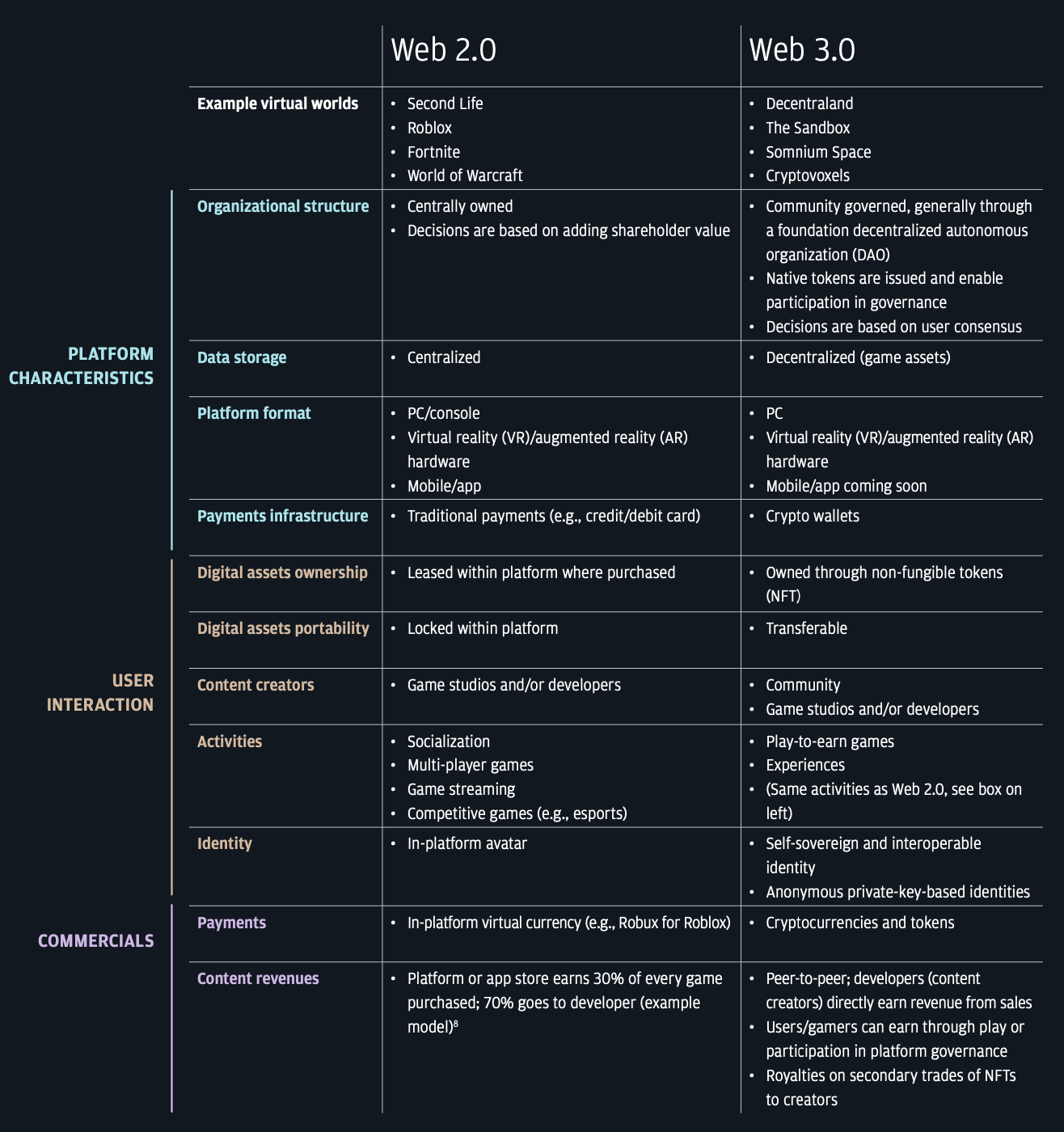
Some interesting anecdotal stats from JP Morgan include
- Every year, $54 billion is spent on virtual goods, almost double the amount spent buying music
- Approximately 60 billion messages are sent daily on Roblox
- GDP for Second Life was about $650M in 2021 with nearly $80M USD paid to creators
- Non-fungible tokens (NFTs) currently have a market cap of $41 billion
- Price of a parcel of virtual land doubled in 2021, from $6k in June to $12k by December
- In-game ad spending is set to reach $18.41 billion by 2027
The concept of a metaverse is not a new one. “In many ways this is a linear progression. Online, multi-player, role-playing worlds like The Sims or Second Life have been around for nearly 20 years, with players spending an average of 20 hours per week in these worlds.9 Modern equivalents like Minecraft, World of Warcraft and Fortnite have hundreds of millions of users, and huge supporting economies.”
Here is a useful timeline from JP Morgan’s report, showing development over the last 20 years (it seems a long time since I was designing my avatar to live in Second Life!):
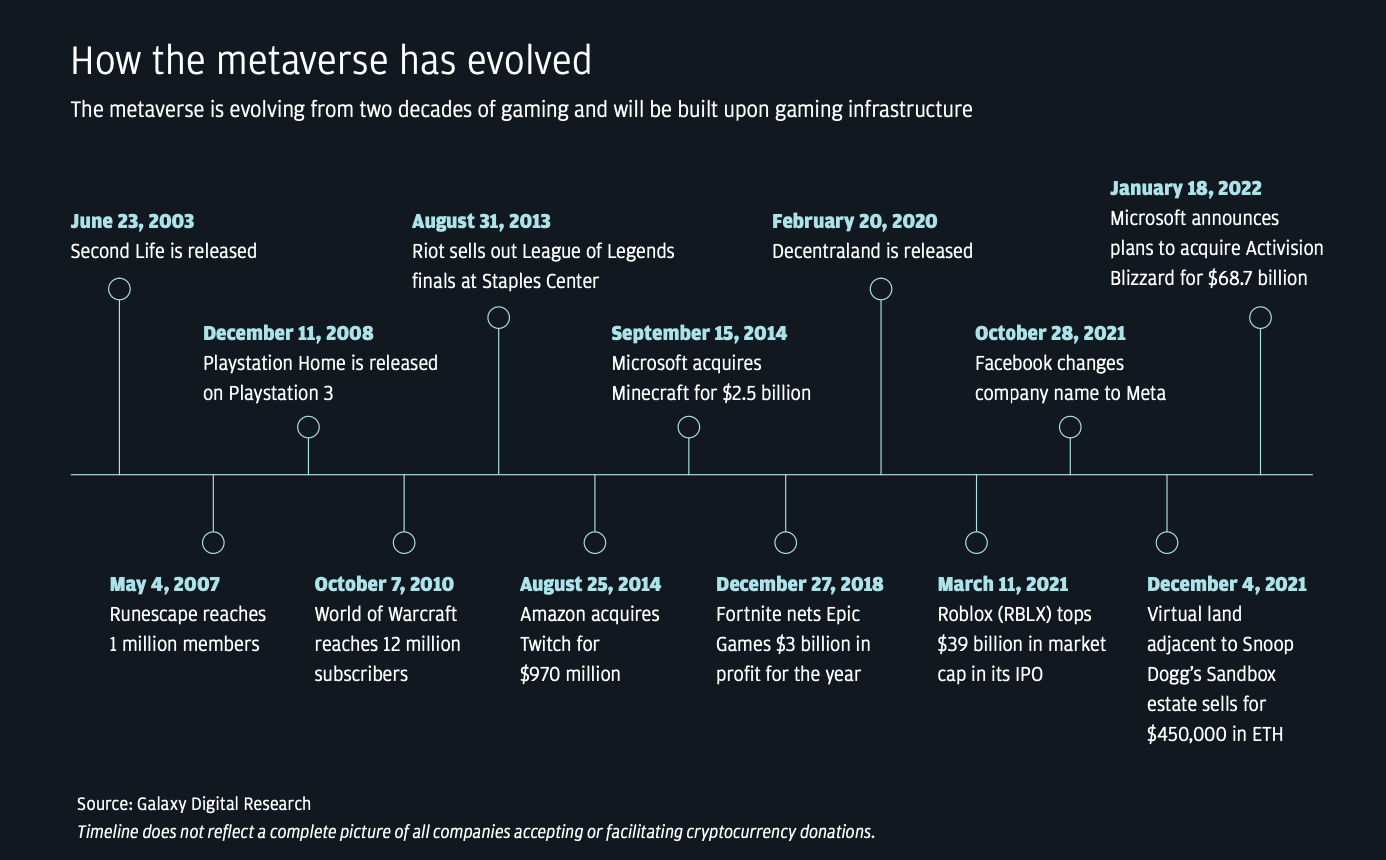
We are now at an inflection point, where “metaverse” talk seems to have reached peak hype. This is fuelled by tech companies and media, but also due to a convergence of emerging trends.
A number of new technologies have come together to enable this vision of the metaverse. Augmented reality (AR) and virtual reality (VR) headsets have become cheaper and more powerful, improving the user experience. Blockchain has enabled digital currencies and NFTs. The new methods to transact and own digital goods are allowing creators to monetize their activities through tokens. In addition to monetization, and as a means to exchange value, token-holders can also participate in the platform’s governance (e.g. vote on decisions). This democratic ownership economy coupled with the possibility of interoperability, could unlock immense economic opportunities, whereby digital goods and services are no longer captive to a singular gaming platform or brand.
Credit Suisse, in a new report “Metaverse: A Guide to the Next-Gen Internet” says “the metaverse is best understood as an evolution of the internet into a more spatially immersive, compelling, and frictionless 3D web, viewable by virtual reality (VR) and augmented reality (AR), along with traditional compute devices, with three key aspects: presence, interoperability and standardisation. There are five key vectors for metaverse advancements, in our view: (1) hardware; (2) infrastructure; (3) content; (4) community; and (5) currency/settlement mechanism.
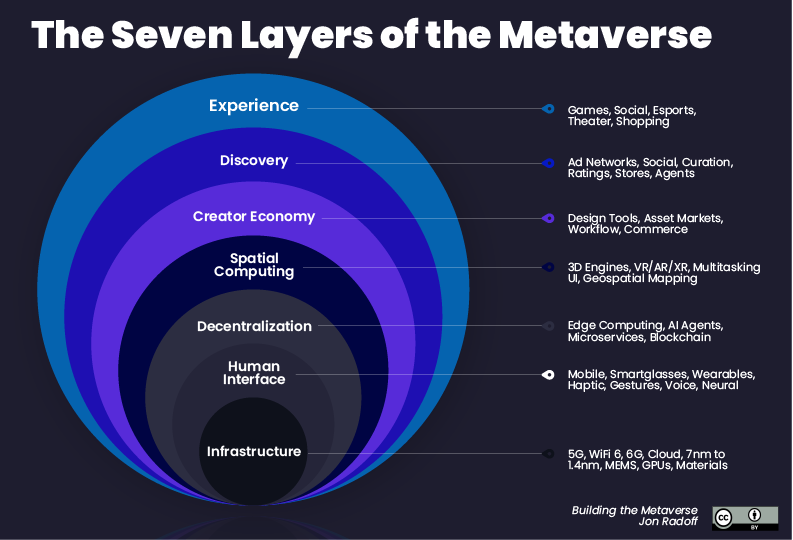
Jon Radoff, CEO of Beamable, a Live Game Services platform, is a prominent industry commentator on the topic of the metaverse. His prior work has focussed on online communities, internet media and computer games. He sees the metaverse as composed of seven layers:
- Experience: The experience layer is where users do things in the metaverse including gaming, socialising, shopping, watching a concert or collaborating with co-workers. The metaverse experiences do not need to be 3D or 2D, or even necessarily graphical; it is about the inexorable dematerialisation of physical space, distance and objects. When physical space is dematerialised, formerly scarce experiences may become abundant.
- Discovery: The discovery layer is about the push and pull that introduces people to new experiences. Broadly speaking, most discovery systems can be classified as either inbound (the person is actively seeking information about an experience) or outbound (marketing that was not specifically requested by the person, even if they opted in). The discovery layer could include the curated portals, online agents, rating systems and advertising networks drawing users to discover different areas.
- Creator economy: Not only are the experiences of the metaverse becoming increasingly immersive, social, and real-time, but the number of creators who craft them is increasing exponentially. This layer contains all of the technology that creators use daily to craft the experiences that people enjoy.
- Spatial computing: Spatial computing has exploded into a large category of technology that enables us to enter into and manipulate 3D spaces, and to augment the real world with more information and experience. The key aspects of such software includes: 3D engines to display geometry and animation; geospatial mapping; voice and gesture recognition; data integration from devices and biometrics from people; and next- generation user interfaces.
- Decentralisation: The ideal structure of the metaverse is full decentralisation. Experimentation and growth increase dramatically when options are maximised, and systems are interoperable and built within competitive markets. Distributed computing powered by cloud servers and microservices provide a scalable ecosystem for developers to tap into online capabilities without needing to focus on building or integrating back-end capabilities. Blockchain technology, which enables value- exchange between software, self-sovereign identity and new ways of unbundling and bundling content and currencies, is a large part of decentralisation (this area of innovation can be called Web 3.0).
- Human interface: Computer devices are moving closer to our bodies, transforming us into cyborgs. Smartphones have evolved significantly from their early days and are now highly portable, always- connected powerful “computers”. With further miniaturisation, the right sensors, embedded AI technology and low-latency access to powerful edge computing systems, they will absorb more and more applications and experiences from the metaverse. Dedicated AR/VR hardware is also coming into the market, and in the coming years will likely evolve significantly. Beyond smartglasses, there is a growing industry experimenting with new ways to bring us closer to our machines such as 3D-printed wearables integrated into fashion and clothing.
- Infrastructure: The infrastructure layer includes the technology that enables our devices, connects them to the network and delivers content. This includes the semiconductors, battery technology, cloud servers and storage, and 5G and Wi-Fi transmission required. The infrastructure upgrades on compute, connectivity and storage supplemented by AI should dramatically improve bandwidth while reducing network contention and latency, with a path to 6G in order to increase speeds by yet another order of magnitude.
Meta Platforms, having staked its future on evolving its fading Facebook social media platform into the driving hear of a future “metaverse” by 2030, has just published a new report with Analysis Group titled “The Potential Global Economic of the Metaverse”, that also seeks to quantify the economic opportunities in Web3, suggesting an estimated a “gross metaverse domestic product” of $3 trillion in 2031.
“One way to think about the metaverse is as a set of interconnected digital spaces, including immersive XR experiences that combine the digital and physical worlds, in which individuals can easily move between different spaces and experiences as well as interact and collaborate with other people who are not in the same physical space,” the Meta-sponsored research says. “Some of the early components of the metaverse and the experiences and activities it is envisioned to support or enable are already in exhibit, such as augmented reality, virtual reality, mixed reality, blockchain, and non-fungible tokens.”
Since reinventing itself as Meta, Zuckerberg’s company lost $3 billion in Reality Labs, in the first quarter of 2022. Reality Labs is its division that experiments with virtual and mixed reality and other tech. The report cautions that the path to the metaverse will not be smooth. It also compared the metaverse to the rise of mobile devices saying “While it is possible that, like many other previously ‘hyped’ technological innovations, the metaverse never comes to fruition as currently envisioned, the goal of our analysis is not to predict whether the metaverse will be successful,” but “to focus on measuring the potential economic impact of the metaverse if it were to evolve like prior successful technologies.”
Find out more
- Metaverse Myths and Magic: New Keynote by Peter Fisk
- Winning with the Megatrends, Markets and Metaverses: Keynote by Peter Fisk
- Business Recoded: Have you the Courage to Create a Better Future? by Peter Fisk
- The Future MBA. Everything you need to Lead the Future: 3-day workshop by Peter Fisk
- Purpose, Vision and Strategic Roadmap: Facilitated consulting led by Peter Fisk
Contact peterfisk@peterfisk.com